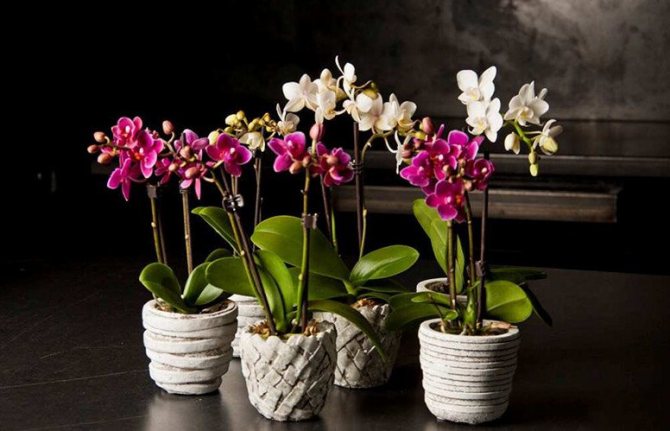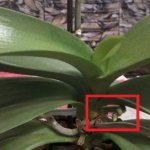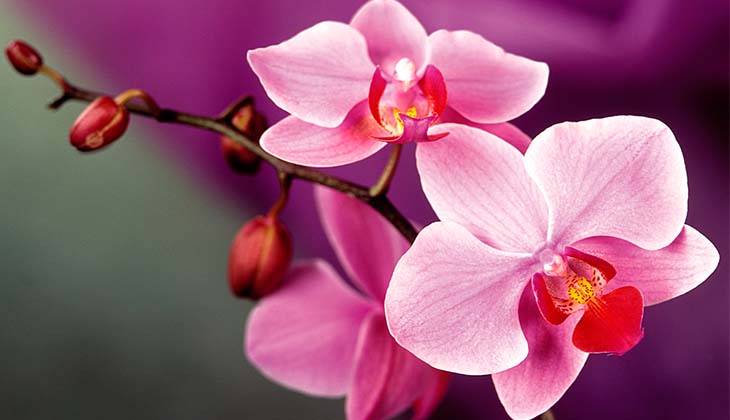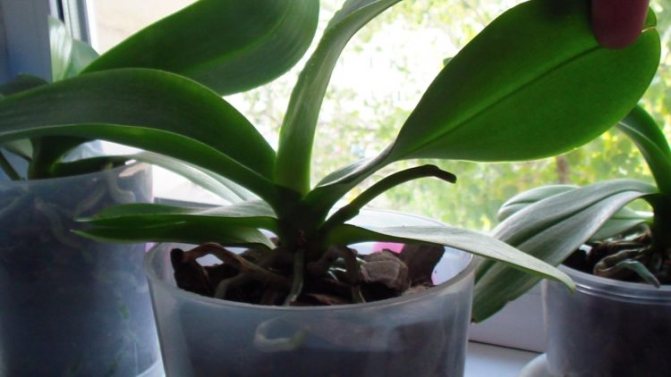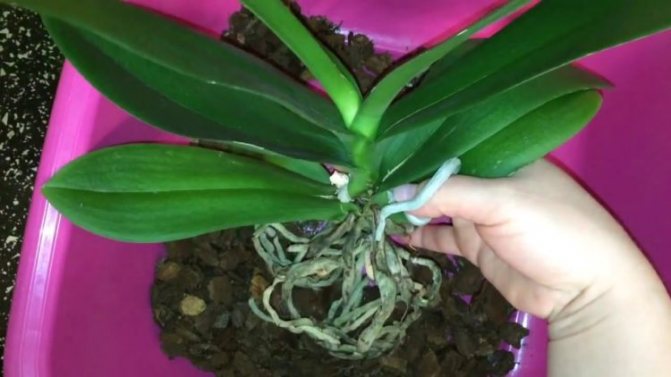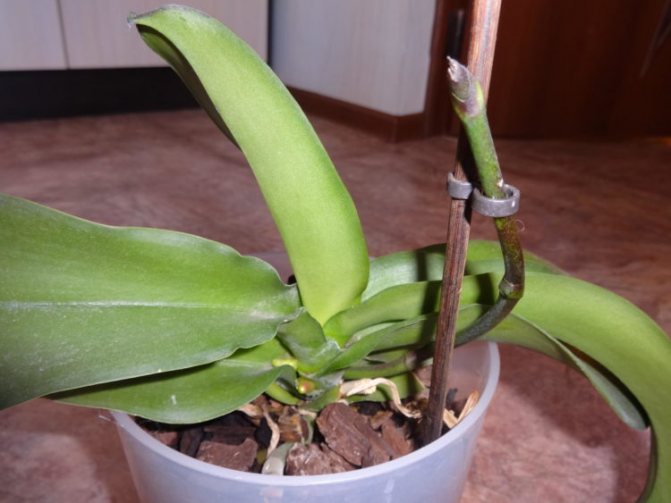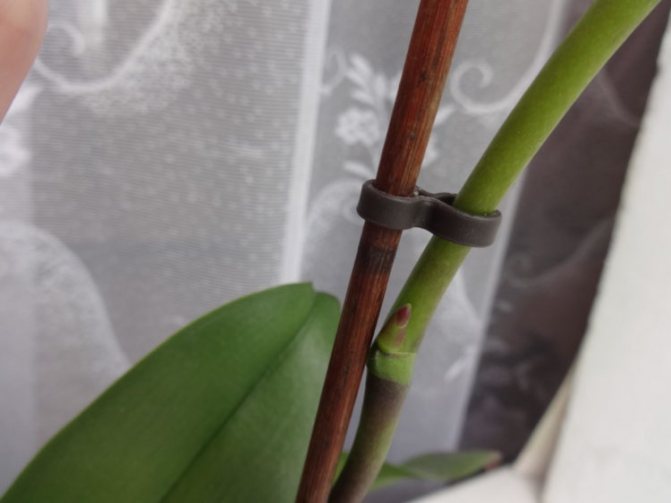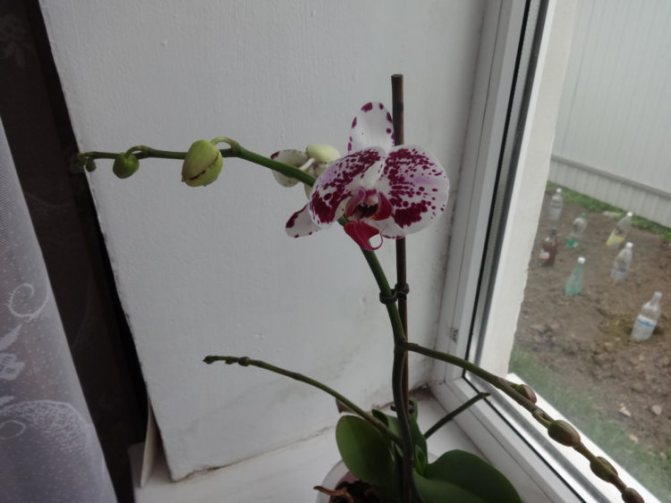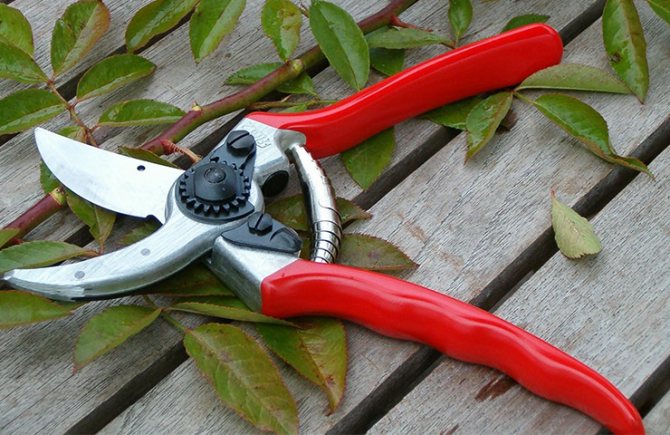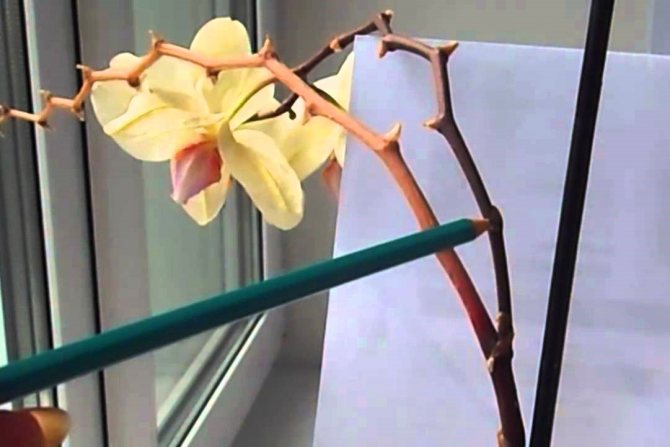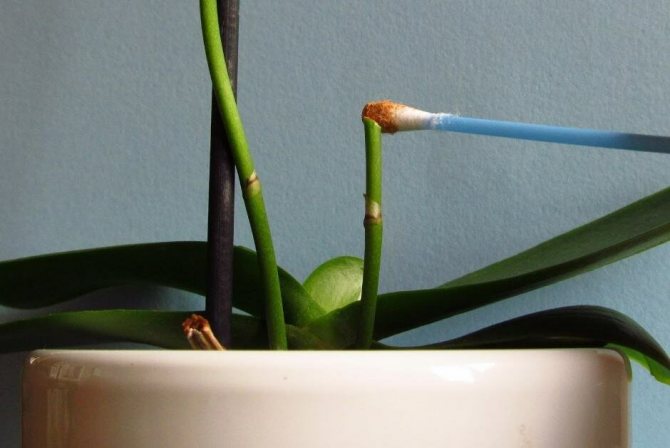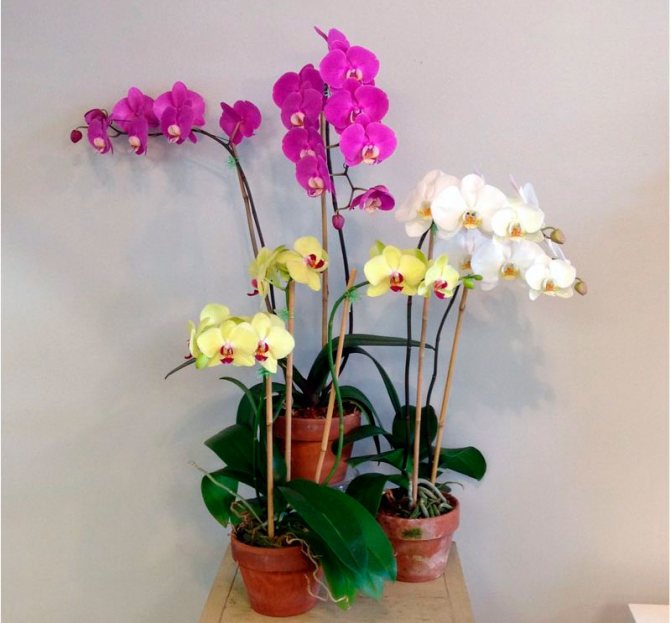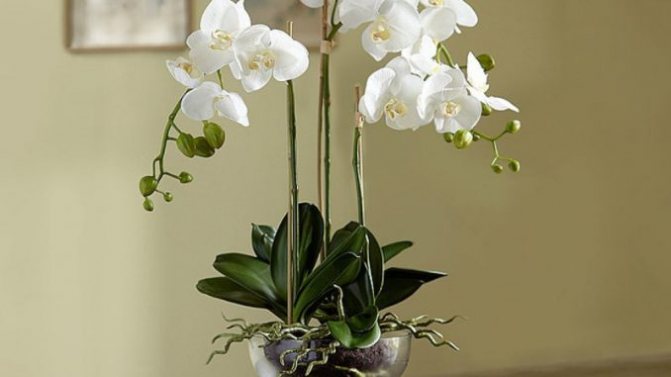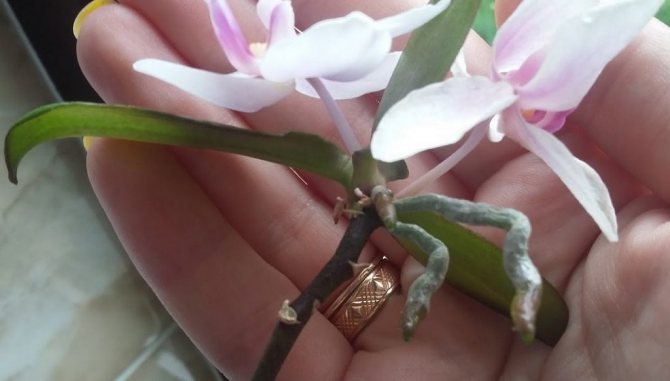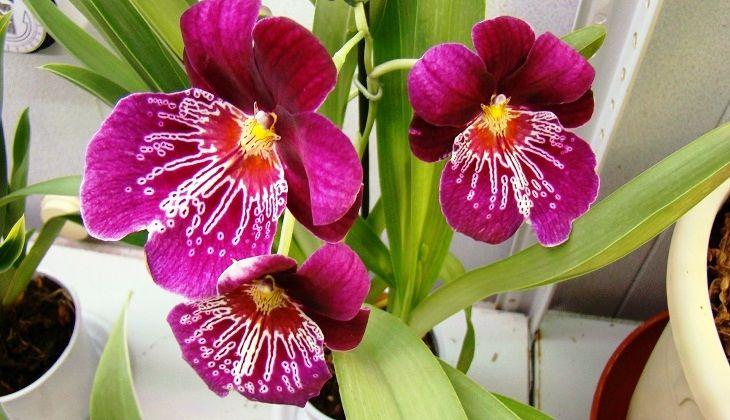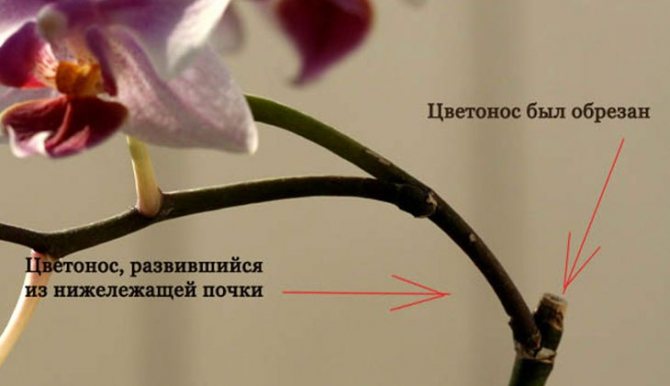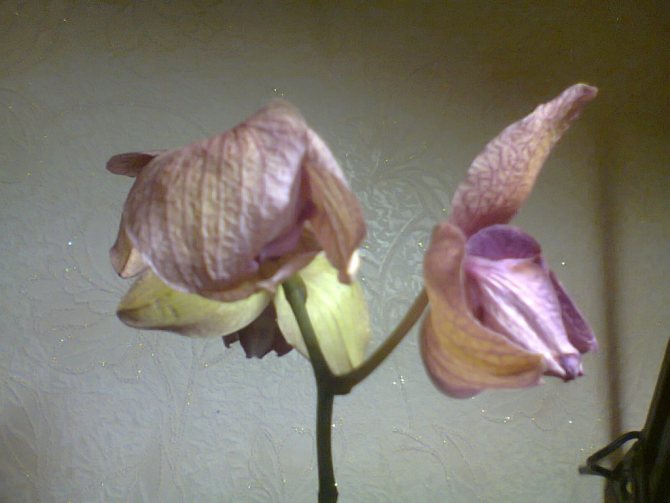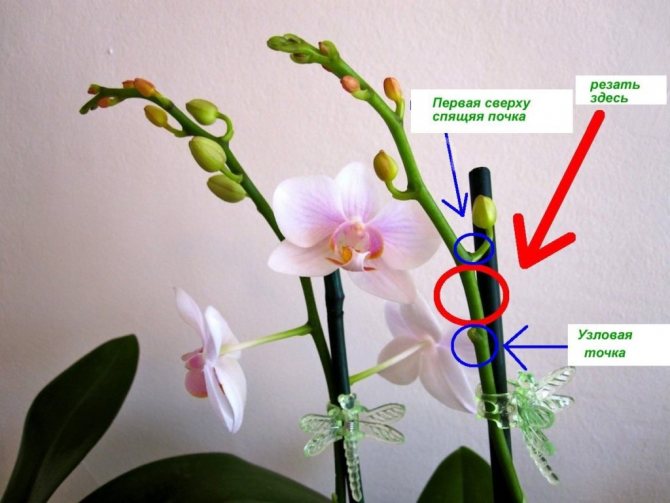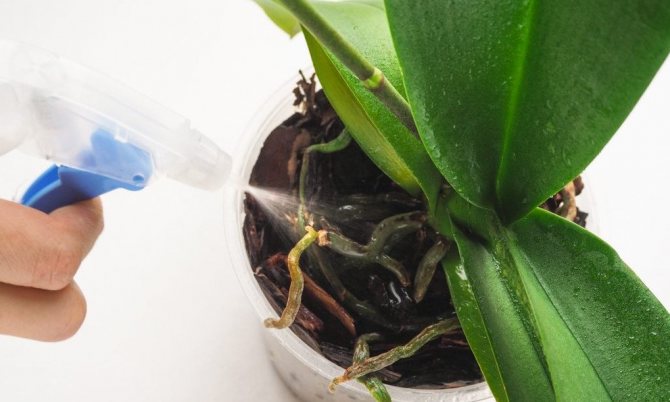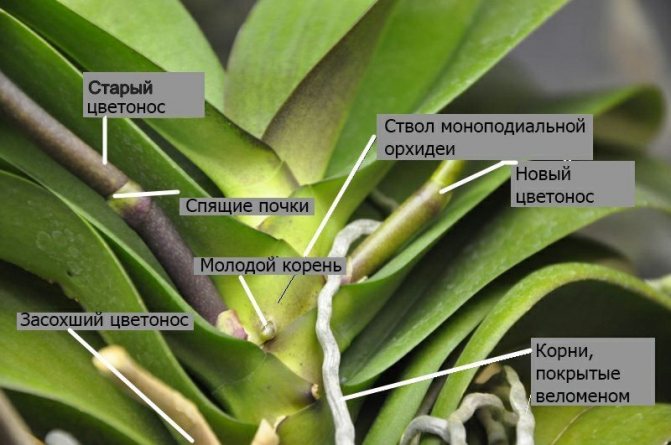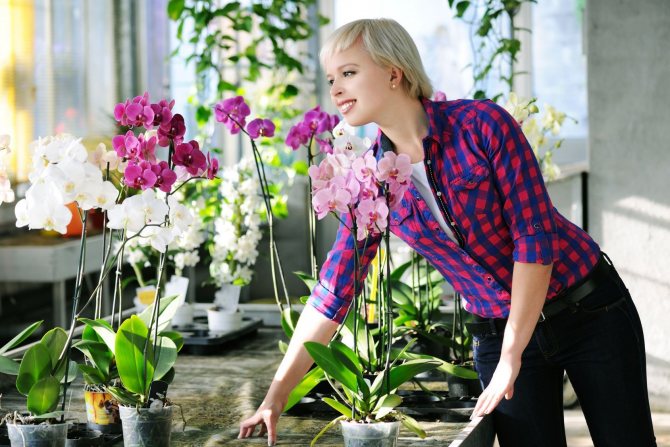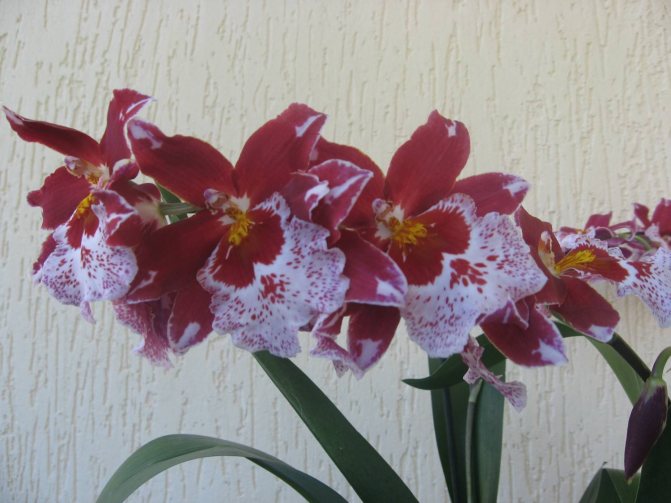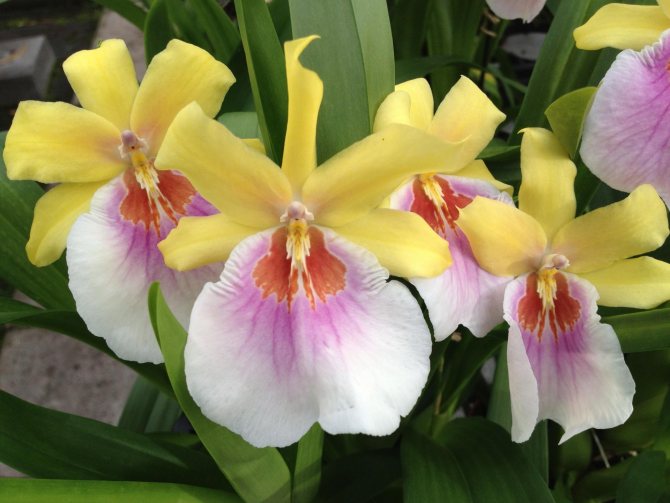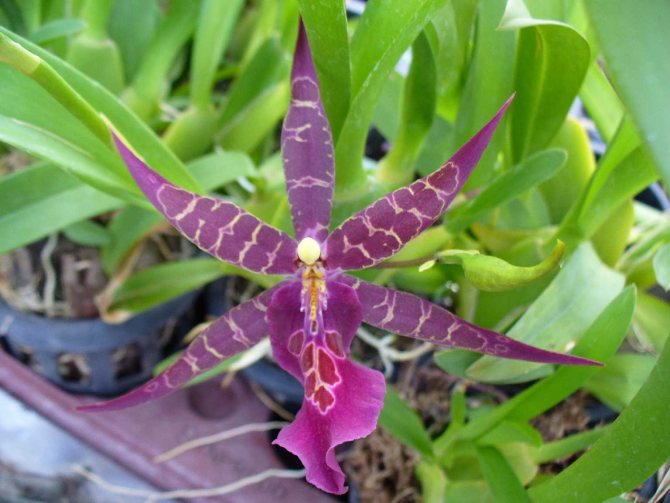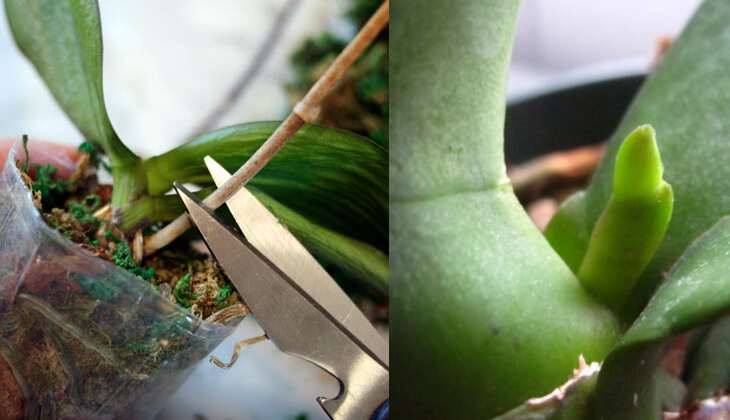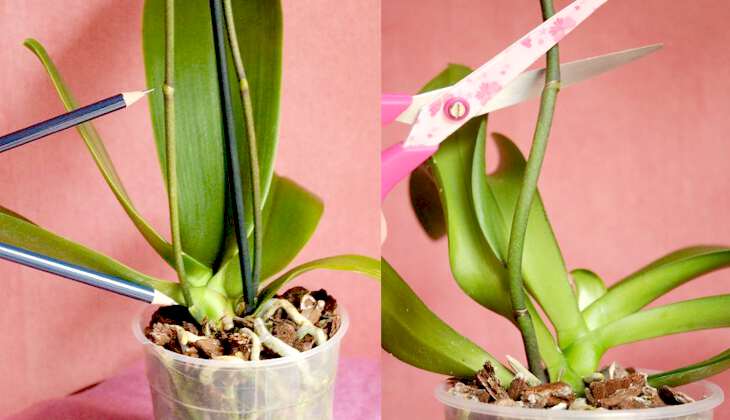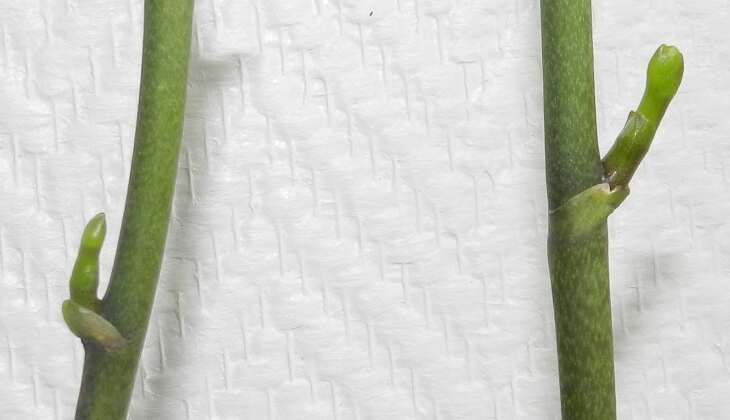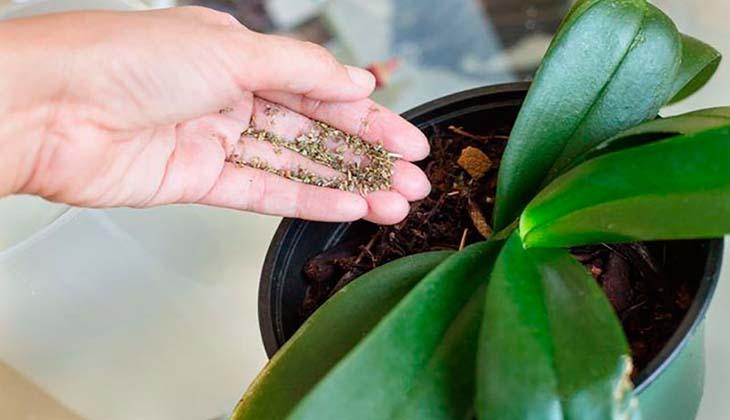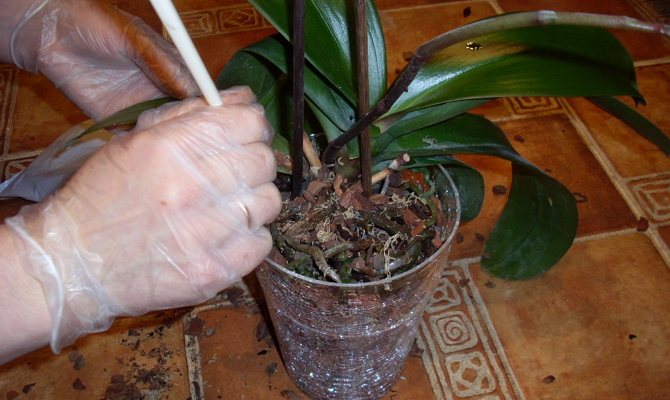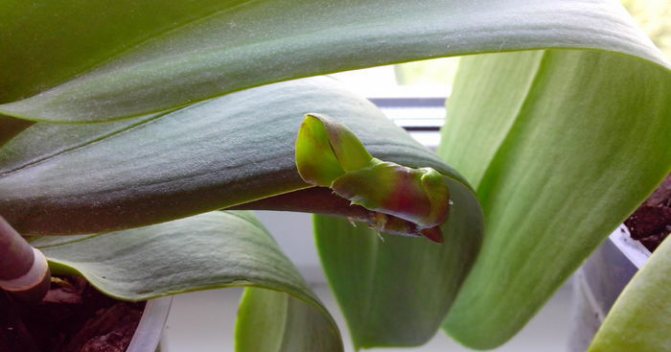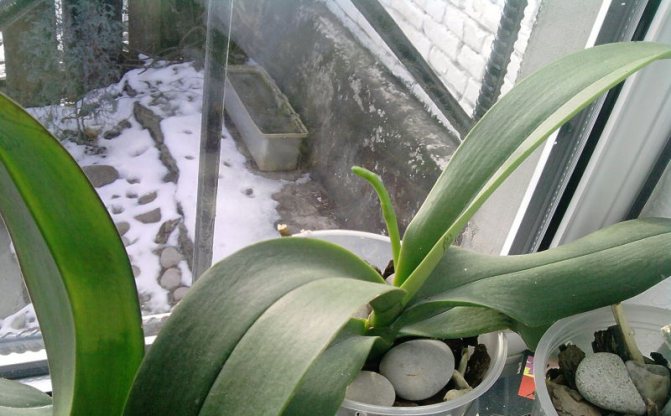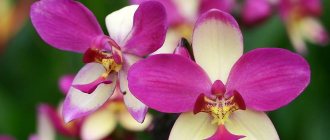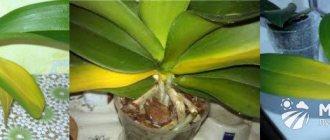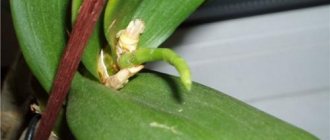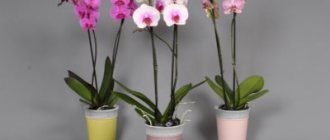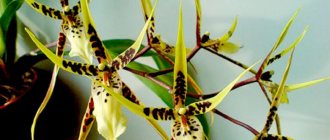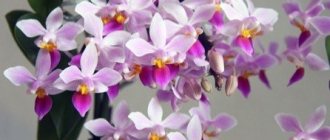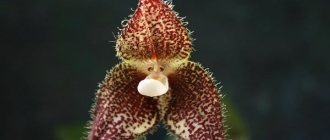The most famous variety of indoor orchids is the Phalaenopsis genus.
They deserve special popularity thanks to extraordinary beauty, long flowering and unpretentiousness in indoor growing.
Phalaenopsis requires special attention during the end of flowering. The ability of the plant to bloom regularly and continuously will depend on what you do with the peduncle.
What does it look like?
The arrow looks like a long stem (in favorable conditions it can reach 80 - 100 cm in length) of green cone-shaped color, without flowers, which most often grows above the place of the previous flowering. The arrow is not smooth, but has irregularities - the places where plant buds are formed: dormant and flower. From the flower buds and orchid flowers are formed, and from the sleeping ones, a side arrow or a baby may appear.
The peduncle does not always grow up, sometimes it can grow to the side or down. It can also bizarrely bend, for example, in the form of a pig's tail.
The peduncle is a long, bright green stem of a stepped shape, appearing most often between the leaf plates of an orchid, at the top of which an inflorescence is formed. Its pointed tip is the same color as the shoot itself. The peduncle is not smooth: the buds of the plant "sleep" under the scales.
How long does a peduncle grow in a phalaenopsis orchid?
From the beginning of the growth of the peduncle to the opening of the first buds, it usually takes about two months. The duration of the growth of the peduncle depends on the illumination: the more light, the faster the peduncle forms.
If you followed my advice and did not cut the peduncle completely after the end of the main flowering, then with the arrival of autumn, a lateral peduncle may begin to grow from the "sleeping" buds of your orchid. Keep in mind that the lateral peduncle forms faster: as a rule, a month after the lateral peduncle begins to grow, the orchid will already delight you with its flowering.
General Provisions
The appearance of flowers and the duration of the color is a long way to prepare both the plant itself and its owner. To correctly capture the moment when the plant is ready for the release of the peduncle and the formation of buds, it is necessary to understand the life cycles of orchids. There are 5 of them, and this suggests that each of them is consistently different from the previous one.
- The growing season. The total volume of the orchid increases due to the roots and leaves.
- Peace. The period of the release of peduncles.
- Bloom. On the peduncle of the orchid, buds form and flowers bloom.
- Relaxation.
- Active vegetation. Growth of new roots and leaves.
In our climatic zone, the dormant period for orchids occurs in late summer or early autumn. It usually takes about a month before a new shoot starts to grow, so we can say that October-November is the ideal time for it to appear. Experienced flower growers do not confuse young shoots with aerial roots, while inexperienced ones often make such a mistake, followed by wrong actions.
Indeed, during the formation of the shoot, the plant cannot be transplanted, as this will lead to severe stress. A new peduncle does not always begin to grow.It happens that a dormant bud on the old one awakens and a young shoot is formed from it.
Extending flowering by pruning above the bud
Trimming the flower-bearing arrow over the sleeping bud does not prolong the flowering of phalaenopsis, but shortens the periods between flowering due to the fact that the orchid does not spend time and energy on the formation of a new peduncle.
Advice! If the orchid has been growing on an old substrate for several years or has root problems, then the dormant period of the plant can be used to transplant into new soil.
How did the flower sprout?
The flower arrow, as a rule, has a solid, rich green color. It is covered with small scales along its entire length. The peduncle grows in different ways: bending, in the form of a pig's tail, or rushing vertically upward or deviating in any direction. It is during the growth process that the flowering process should not be touched. Especially replanting the plant.
At the first centimeters of growth, the orchid arrow can be confused with other parts of the plant. However, there are 3 main signs of the difference between a peduncle and aerial roots:
- The place where the peduncle grows is more predictable than the roots. The flowering process emerges from the leaf axils, that is, the place where the leaf comes into contact with the stem. And the root grows at the base of the root collar between the leaves.
- The flowering arrow has a sharp tip, similar to a beak, and the spine has a blunt, round nose.
- The length of the peduncle is covered with rudiments of scales, green in color. And the root has a smooth structure.
An orchid arrow is also called a stem. Actually, they are two different parts of the plant. The buds are attached to the peduncle, and the leaves are attached to the stem.
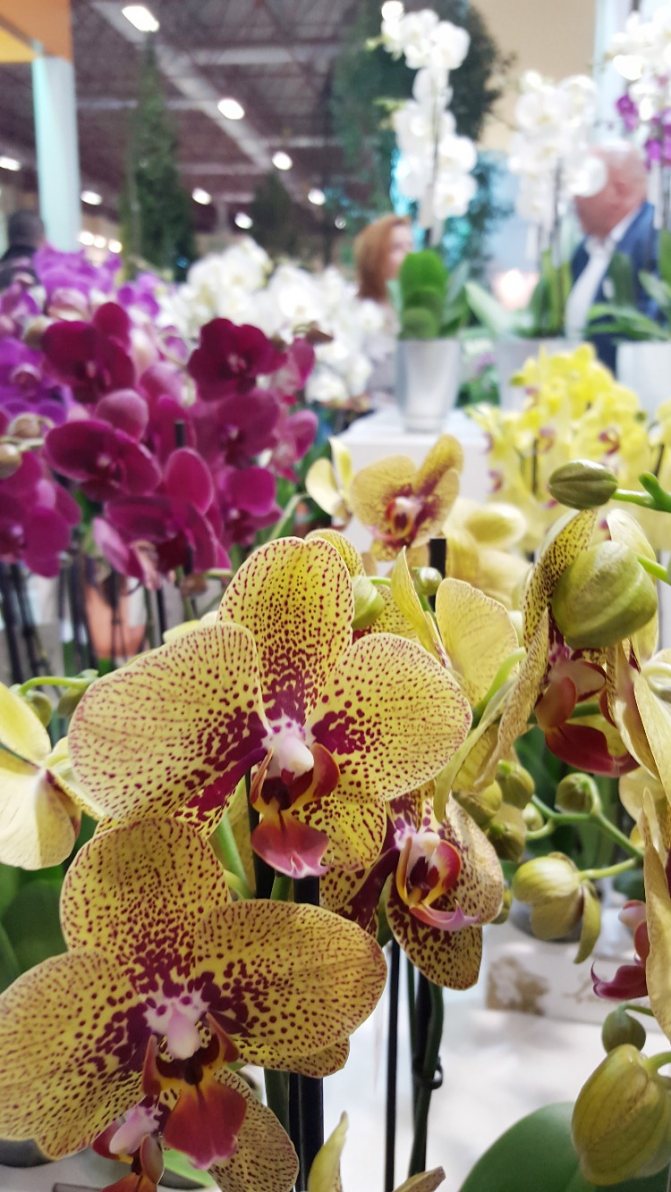
Important. The reasons due to which there are problems with the peduncle depend on what type of orchid we are talking about. Without knowing the peculiarities of caring for a particular orchid variety, one cannot hope for its systematic, abundant flowering!
All orchids are divided into sympoidal and monopoidal. The latter have only one point of growth, the bush does not divide, it does not have a dormant period: Wandas, Phalaenopsis, Ascocenda. Sympoids, on the other hand, need a period of rest, which should be properly provided. In other words, what is good for phalaenopsis and dendrobium will not be relevant for wanda, cymbidium, cattleya.
Before expecting a stalk from an orchid, you need to familiarize yourself with the specialized literature on the creation of the necessary conditions for keeping a certain type of flower. And then it is necessary to analyze: why the orchid does not give a peduncle, whether the created conditions suit it, and if they are not suitable, then what should be done?
Some florists use special preparations such as cytokinin paste. It is a phytoharmonic, its main purpose is to awaken dormant buds, form shoots in the intended place, and accelerate the flowering of a plant. Another drug is succinic acid (4 tablets per 1 liter of water).
Often, novice growers cannot determine whether an orchid has released a root or an arrow. Indeed, it is only a florist with many years of experience that can accurately determine a part of a plant, especially at first. But after some time, when the process reaches 1 cm in length, it will not be difficult to do this.
The main difference is that the tip of the peduncle is sharp and of the same color as the shoot, and the root is rounded and pinkish. Another part of the plant, which is also often confused with an arrow, can be distinguished by its shape - the root baby. It has the shape of a boat.
The root, immediately after its appearance, begins to look down (reaches for the soil and nutrients in it), and the arrow - up (reaches for the light), like the root baby. The root is smooth and the arrow contains "scales".The root grows most often from the neck of the trunk of the plant, the shoot - between the leaf plates.
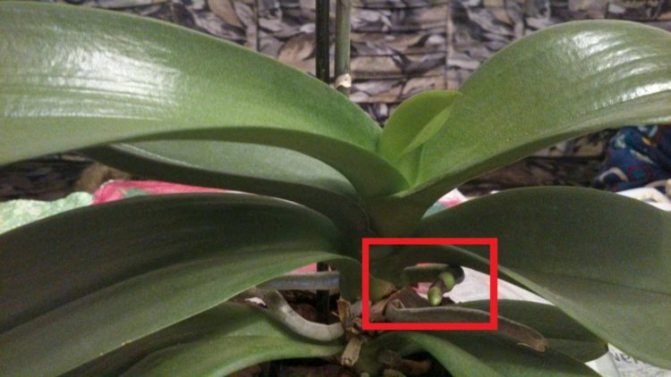

After a period of active growth of roots and leaves, the orchid begins a dormant phase, during which the plant releases an arrow. Most often this period occurs in autumn, but in good conditions the orchid can bloom several times a year.
An orchid shoot is released from the leaf axil, usually the lowest one. The leaf axil is the place where the orchid leaf comes into contact with its trunk. The arrow breaks through the leaf and tends upward. The appearance of an arrow occurs under the influence of many factors: lighting, temperature, watering. If favorable conditions are not created for the orchid, then the formation and release of the peduncle will be impossible.
Only a novice florist may have difficulty in identifying the distinguishing features of the peduncle from other parts of the orchid, for example, the root or root baby. In fact, everything is very simple. It is enough to pay attention to some characteristics, and everything will fall into place.
- The shape of the root is round, the peduncle is cone-shaped, the basal baby is reminiscent of the open beak of a bird.
- At the base of the root collar, next to other roots, a root is formed, a flower-bearing shoot appears only from the leaf axil, from the center of the trunk - a root baby.
- The arrow appears above the place of the previous flowering, grows most often upward, towards the light, but other directions are also possible; the root rushes down to the ground, to moisture, but sometimes it can be directed to the side and up; baby grows up.
- The main difference: there are irregularities on the peduncle - buds, while the root is perfectly smooth, without any irregularities.
Possible problems and solutions
It happens that the peduncle either grows somehow "incorrectly", or is absent altogether.
There is no need to panic. We will deal with each of these cases and consider what a florist should do.
Emergence from the point of growth
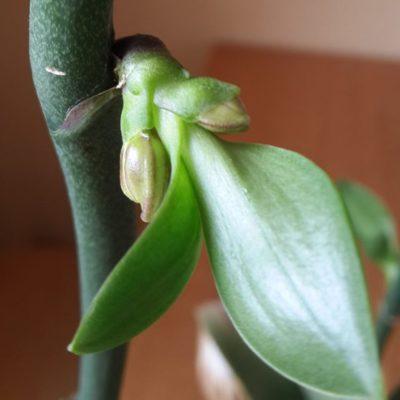

The arrow grows from the point of growth - this happens with older phalaenopsisthat have experienced many flowering cycles. Another reason is the severe stress experienced by the plant. This is the very case when the owner of the plant does not need to do anything. Just take care of your pet as usual. Perhaps the arrow will still give buds or a baby.
Getting multiple stems at home
The number of peduncles on an orchid directly depends on the genetic characteristics of the species that was acquired. An important role is played by such factors as the age of the plant, the power of its root system, the amount and quality of lighting, the regularity of watering, and compliance with the optimal temperature regime.
Provided that all requirements for the care and maintenance of the orchid are met, you can try to increase the number of peduncles as follows:
- After flowering, cut off old peduncles (making sure they are completely dry).
- Treat the leaves and substrate with a fungicide.
- Feed the plant with specialized orchid fertilizers.
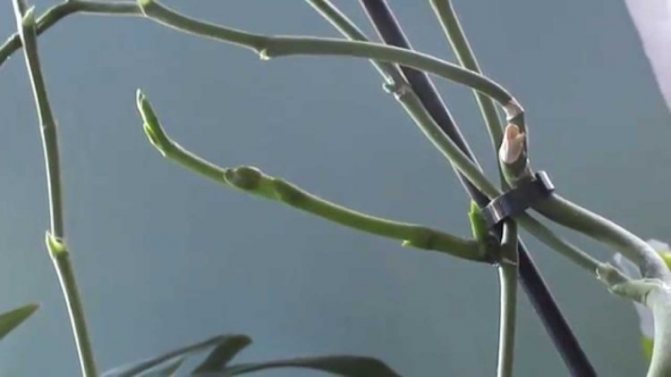

After the flower stalk of the orchid dries to the very base, it must be cut off. To do this, you need sharp scissors or pruning shears, activated carbon. With a sharp, clean tool, a dried peduncle is cut off, not reaching two centimeters to the surface of the substrate. The cut site is processed with crushed activated carbon.
Some florists advise: cut the peduncle not completely, but to the uppermost "dormant" bud, since a lateral arrow can begin to develop from it, and the second shoot appears from the leaf axils. Thus, it will be possible to get a plant with two peduncles.
There are certain requirements for caring for an orchid. They must be strictly followed, especially if the florist wants to see his beauty blooming.
Experienced growers distinguish 5 life cycles of orchids: vegetation (growth of roots and leaves), dormancy (period of flower stalk release), flowering, rest, active vegetation (growth of new roots and leaves).
- Temperature.
The dormant period of the flower most often occurs in the fall. In order for an orchid to give a peduncle, it needs to provide comfortable conditions to the maximum. As a rule, in order for the plant to enter the resting phase without stress, it is recommended to lower the temperature level: from 25C to 15C. The main task is to provide a tangible difference between the readings of the thermometer in the daytime and at night. When the peduncle is already released, the temperature regime rises slightly again. - Watering.
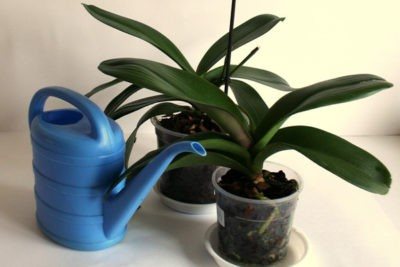

During the growing season, the plant is systematically moistened as needed. It is possible to understand whether moisture is needed visually (the color of dry and moist roots is taken into account) or tactilely (the moisture level of the upper layer of the substrate).
Before the release of the peduncle, an artificial drought is arranged for the epiphyte: another 4 - 5 days are added to the expected time of watering, possibly more. This measure is explained by the fact that in its natural habitat - the tropics - the orchid dissolves its flowers during the "drought" period, since daily tropical showers do not allow insects to fly from flower to flower, thereby pollinating them. Artificial drought in a flower pot will give the orchid a "signal": it's time to bloom!When the peduncle has already been released, then the epiphyte must not be forgotten to water, but this must be done again as the soil dries out. We remember the main rule: it is better to underfill an orchid than to overfill. The recommended interval between waterings is from 7 to 12 days, depending on the living conditions of the beauty.
- Top dressing.
If before the release of the peduncle the orchid was fed, then you should not stop doing this even after the shoot of the shoot until the moment the first flower appears. Fertilization is important before, not during flowering.As a top dressing, it is advisable to use ready-made complex fertilizers for orchids containing nitrogen, phosphorus, potassium. They are sold in specialized stores. If there was no feeding, then you should not start fertilizing the flower during the pasture of the arrow - the consequences can be the most dire.
- Shine.
Often, in order for the orchid to enter the resting phase, it is transferred to a darkened place. After the appearance of the peduncle, the orchid must provide a lot of scattered light for its normal formation (south, southeast, southwest windows).It is important that the daylight hours for a flower are at least 12 hours long. If the growth of the arrow fell on the autumn period (which happens most often), then it is necessary to provide the plant with additional lighting. Phytolamps are usually used for these purposes.
The orchid does not like drafts and air currents. The pot with the plant must be placed away from the air conditioner, fan, radiator. In no case should an orchid with a growing peduncle be transplanted in order to avoid a stressful situation for the plant!
During the growing season, care is based on sufficient nutrition and lighting of the flower, because its health and the level of development with which it will come to a dormant phase depend on it. During the rest period, the care changes somewhat.
Temperature regime
In September-October, the temperature level is slightly reduced in order for the plant to pass to dormancy without stress. The maximum temperature should not exceed 25-26 degrees, and the minimum 15-18 degrees. When the peduncle begins to grow, the temperature regime is slightly increased. If the peduncle of the orchid does not grow, then the intermediate period may not have ended, or the flower is sick. Carefully analyze the conditions in which it is located and make changes. Then it will certainly happen.
Moistening the flower should continue in the same way as before.In order to understand that the plant needs watering, they use visual and tactile methods. That is, if there is condensation on the walls of the pot, then the flower does not need watering and vice versa. As the soil dries, you can tell by touch whether to water.
By October-November, the manner of watering changes somewhat. An orchid can be artificially drought. This is done in the following way. By the time it is time to water, add another 4-5 days of waiting. The appearance of the roots will tell you when it's time to start the waiting period. They take on a silvery hue. If the peduncle does not grow on the orchid, you still need to wait.
Fertilizers
Gardeners often use a variety of ways to feed their pets with great results. This applies to the growth of leaves, roots, flowering. If it is necessary for the peduncle to grow, in no case do not stop feeding the flower even with the onset of the dormant period, because the suspension of fertilization will lead to a halt in growth and development.
How to distinguish from the root or other parts of the orchid?
When phalaenopsis is just beginning to develop a peduncle, it can be mistaken for a root or even a baby of a plant, so you need to know how they differ from each other. It can be distinguished from the root by the following features:
- it is necessary to carefully examine the place where the neoplasm appeared and determine its location relative to the growth point - if it grows from the stem and is located on the root collar between the leaves, this is not a peduncle, but an aerial root;
- the arrow always grows upwards, while the roots are slightly downward;
- the color of the roots is greenish-gray and bright green at the tips, while the arrow is monochromatic along the entire length;
- the root is smooth, and the peduncle is divided by small scales;
- peduncles have a sharp tip, and at the roots it is rounded and blunt.
Differences between a peduncle and a basal baby:
- after the baby grows up slightly, its tip will resemble a boat in shape;
- the peduncle grows only from the base of the central vein of the leaf, and the baby, as a rule, is just above the place of the previous flowering.
We suggest watching a video on how to distinguish a peduncle from a root in phalaenopsis:
Role in plant life
The orchid's arrow performs a reproductive function. Children are most often formed on it - small copies of the orchid itself. After they release a couple of leaves and 3 - 4 roots, they can be rooted.
In addition, the peduncle is involved in the appearance and development of flowers and buds, nourishes them with water and nutrients, thereby continuing to perform the reproductive function. Each orchid flower contains a seed capsule in which the seeds ripen after pollination by insects. An orchid can also be grown from seeds, but this can happen either in the natural environment - the tropics, or in laboratories, since this process is long and whimsical.
The peduncle plays an important role in the life of an orchid: in addition to the aesthetic function provided by the long flowering of the plant, the stem performs the function of reproduction in natural conditions. The flower, located on a peduncle, attracts insects with its beauty, which pollinate the orchid. The peduncle raises children, which then become a new young plant, if rooted.
Peduncle pruning
After the buds fall off, the old arrow is cut off to put the orchid into a dormant state. The plant is able to shed the peduncle, but the sooner the arrow is removed, the faster the orchid will bloom again. The dead shoot will consume the plant sap, which will prevent the orchid from blooming again.
Pruning is carried out 3-4 days after the end of flowering. There are several rules for the procedure:
- For work, a sharp garden pruner is used, which is disinfected with alcohol.
- After pruning, a short shoot should remain, about 2-3 cm.
- The cut site is dried with cotton wool and treated with activated carbon.
Sometimes the shoot does not stop growing after the flowers fall. After a while, new buds form on such an arrow.
On such a shoot, children with roots and buds can also form. They are used to grow shoot orchids.
How important is flowering?
The flower stalk is the most important part of the orchid. Some florists call it the “heart” of the plant. It is he who provides all the beauty of the orchid, since flowers are formed on it. As you know from biology lessons, a flower is a means by which a plant attracts insects for its pollination, that is, for procreation. As a confirmation of this, it is on the peduncles that babies appear, which can then be easily rooted and get a new plant.
While the flower stalk of the orchid is growing, the plant should never be transplanted!
After pruning the orchid, a part of a healthy peduncle may remain, on which new shoots will develop. Several methods are used to activate dormant kidneys.
- Watering with warm water. An increase in water temperature leads to an increase in metabolism within the plant. This will awaken the dormant buds and the orchid will release a flower stalk.
- The use of phytohormones. Such a drug is cytokinin paste. Scales are removed from the sleeping kidney with tweezers and a small amount of ointment is applied to it. The active substances that it contains nourish the kidney and enhance the metabolism.
The orchid flower stalk is an important organ for flower reproduction in natural conditions. At home, you need to make a lot of effort in order for the orchid to sprout.


Not only phytostimulants are suitable for fertilizing a flower. Also, at home, it is good to use nitrogen-phosphorus-potassium fertilizers, which develop roots, leaves, and improve all metabolic processes inside the flower. In addition to the triad, mineral fertilizers are used, which increase their bioavailability and activate the processes of peduncle formation.
In this article, we talked about what needs to be done to get the phalaenopsis to release a peduncle.
Care
After pruning, the orchid enters a dormant period, but, as before, needs care. As a rule, it is no different from caring for phalaenopsis in other phases of growth:
- the plant requires regular watering and spraying;
- after flowering it is recommended for a certain period reduce the amount of dressingsto give the plant an opportunity to rest;
- after 2-3 months of rest, to stimulate a new peduncle, you can increase the intervals between waterings and provide temperature difference in the room.
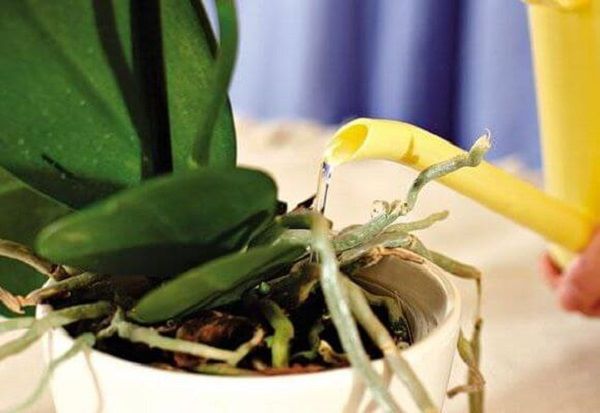

After flowering and pruning, the orchid requires regular watering.
After a short rest, the phalaenopsis will bloom with renewed vigor.
Epiphyte problems
Does not fire an arrow
If all the requirements for care are met, the orchid blooms once a year (maybe more often). Why sometimes does she not release a peduncle? There are a number of reasons for this. Insufficient lighting, improperly chosen substrate, lack of feeding, stressful state of the plant, improper watering - this is a list of the main negative factors affecting the state of the epiphyte, and, therefore, its desire to bloom.
- If the orchid does not have enough lighting, then it does not release a peduncle, but increases the mass of leaves. And when a peduncle appears, buds are not laid on the shoot. The way out of the situation is simple: increase the amount of light, but you should not avoid direct sunlight. In the summertime, it is important to remember to shade the plant.
- If the substrate is incorrectly selected or the plant is not fed, then the grower does not need to harbor hopes of seeing his beauty blooming.It is important to remember that the epiphyte loves moderation in everything: an excess of fertilizers can also negatively affect the state of the plant.
For feeding, it is better to use complex preparations intended only for orchids and purchased at a flower shop. For example, "Kemira Lux" or "Bona Forte". Before use, be sure to read the instructions for these fertilizers. The same applies to the substrate: for planting or transplanting an orchid, a soil is used that is intended only for this flower. - Stress has two opposite sides. Sometimes experienced flower growers arrange "shock therapy" for their orchid in order for it to release a peduncle (cold, drought, darkness). But stress can have a detrimental effect on the flower. Be sure to remember that everything is good in moderation.
- Watering for an orchid is one of the basics of flowering. Moisture affects the laying of the future peduncle and buds. If the epiphyte is watered excessively, then the root system will surely begin to rot, and the buds will dry out. During the growing season, watering should be systematic, and after the appearance of buds, the frequency of watering is usually reduced.
For the appearance of a peduncle, it is recommended to install a container with an orchid in a water bath for 1 hour, during the rest period, watering stops completely. - Humidity. Orchid is a tropical plant that loves humid air. But not during the period of peduncle release. The indicator of the level of humidity in the room where the epiphyte is located should not exceed 30% - 40%.
Sometimes the flowering arrow stops growing, for this there may be a number of reasons that are almost identical to those listed above.
- Insufficient illumination. The way out is to rearrange the plant in a more illuminated place.
- Rotten roots. The solution must be radical: the plant needs a transplant. And although this is not recommended during the period of flower stalk release, here we are already talking about the life of the whole flower as a whole.
- Insufficient watering. The way out is to adjust the irrigation pattern. You can cover the top layer of the substrate with sphagnum moss, which will contribute to additional moisture, and also change the acidity of the substrate, after which the peduncle can grow again.
The period of growth of the peduncle - from the moment of appearance until the moment the first flowers appear - is usually about two months.
Dries up
Sometimes the already practically grown peduncle begins to dry out. Why? Here are some of the main reasons:
- Transplant response. The plant assimilates to a new substrate “discards” unnecessary parts. As a rule, this is a peduncle and lower leaves.
- No difference between day and night temperatures. In the bright sun, all metabolic processes in the orchid begin to accelerate, new cells begin to form, and for them the flower needs carbon. The supply of this element is replenished during the cool night time.
If it is hot at night, then the plant begins to experience a lack of carbon, and, therefore, take the missing from its old cells. The largest supply of carbon is contained in the peduncle, so it dies. - Lack of nutrients: nitrogen, potassium, phosphorus. They are also "pumped out" by the plant from its parts.
As a way out of this situation, experienced flower growers recommend cutting off the drying peduncle to living tissues. This can stop shrinkage, and a new lateral shoot may grow from the dormant bud. If this does not happen, then the arrow will have to be cut off completely, leaving a stump of 1-1.5 cm, and wait for the next peduncle a few months later.
Unfortunately, the release of a peduncle by an orchid does not always mean that it will soon bloom. For this to happen, you need to fulfill all the basic requirements for the care and maintenance of the flower. And if this did not happen, you should not be upset, you just need to take into account all the nuances that were discussed in the article, and wait for the next period of flowering of the epiphyte.
Photo of peduncles
Phalaenopsis orchid, as a rule, blooms two, rarely three times a year. The duration and frequency of flowering are hereditary factors and differ in different species of phalaenopsis.
Has a significant impact also:
- the state in which the plant is;
- the conditions for its cultivation;
- leaving after the end of flowering.
Such care can be very different for different types of orchids.
If the species of phalaenopsis is unknown, it is better to observe the behavior of the flowering shoot after the flowers fall:
- it changes color, turns yellow and dries, sometimes acquires a brown or bright yellow color;
- the flower stem dries up partially;
- the peduncle remains green.
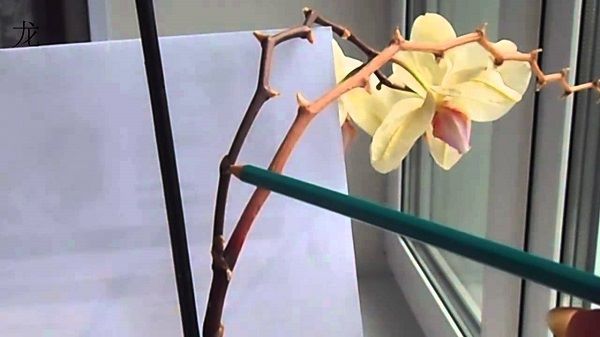

The peduncle changed color.
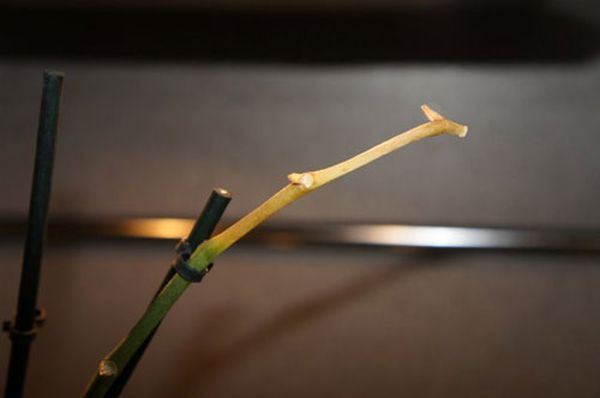

The peduncle is partially dry.


The peduncle remained green.
Some representatives of the Phalaenopsis genus (F. corning, F. deer-horned) form long-lived peduncles that grow after each subsequent flowering and form buds on them for many years.
What is a flowering shoot?
An arrow is the first sign of an imminent flowering. Under favorable growing conditions, it reaches a height of 80-100 cm and carries up to 80 flowers. With its appearance, the flowering process begins: buds are formed, which subsequently grow, develop, and bloom. The peduncle is involved in the development of inflorescences, nourishes them with moisture, nutrients. The duration of the flowering stage reaches 3 months on average.
Also, the peduncle is involved in reproductive function. With perfect care, babies can form on the hatched flowering process. They germinate at the end of flowering, and stay on the peduncle until fully formed.
Important! When the baby has 3-4 roots and a couple of leaves, it is cut off for independent growth.
A peduncle is a shoot (arrow) extending from the base of a plant upwards, on which flowers are formed, or, in a narrower sense, a segment of a plant stem on which flowers are formed.
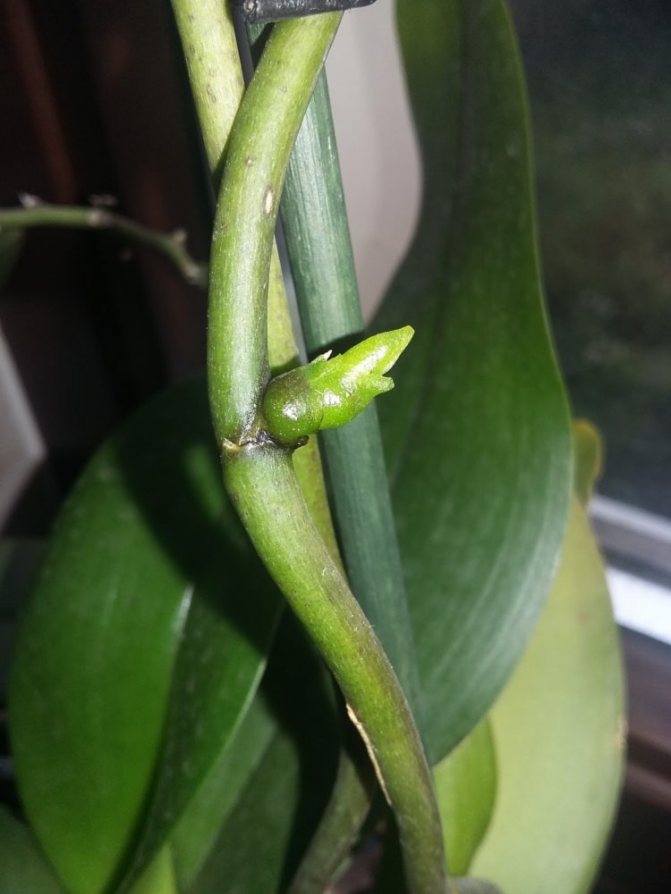

The peduncle is very similar to the root of an orchid, so often inexperienced growers make irreparable mistakes in caring for the plant, which can lead to fading or death of the peduncle. What are the main differences between a peduncle and a root?
- The shape of the root is round, and the peduncle is conical.
- The flowering shoot appears only from the leaf axils.
- An arrow appears above the site of the previous bloom.
- Necessarily the presence of irregularities on the peduncle - the kidneys.
Most often, the orchid produces flower stalks in the fall, when the temperature differences between day and night are large: from 25C to 15C. The average term for the formation of a flower arrow is 2 - 3 months (from the moment of appearance to the phase of the formed peduncle). If the grower creates comfortable conditions for the plant, then this process can be accelerated. At the same time, this will give a guarantee that the home beauty will definitely bloom.
Peduncle characteristic
A peduncle is the shoot of a plant on which buds, buds and seeds are formed. The orchid produces one shoot during the flowering period. With the help of the arrow, the flower is multiplied.
The size of the shoot is from 10 to 30 cm. When the arrow reaches more than 10 cm, it should be tied up. The arrow must not be long. If the peduncle begins to grow more than 40 cm, the top is cut off by 2-3 mm.
The buds grow in the 2nd month from the beginning of the formation of the arrow.
The peduncle is responsible for flowering. In the process of growing an orchid, it is important to adhere to a number of rules so that the plant will release an arrow.
Care during the growth of the peduncle
During the period of active growth, favorable conditions are created for the plant. Factors affecting growth include:
- Illumination. A little light will affect the development of the shoot.
- Watering. After the arrow begins to climb, the plant is watered as the soil dries up.
- Top dressing. Top dressing will help to increase the number of buds. The orchid is fertilized before the first bud appears. Application of top dressing after the beginning of flowering will lead to the fall of flowers.
The flower should not be repotted as it can cause stress. If the peduncle has stopped growing, then it is cut off. The cut site should be treated with wood ash.
Peduncle damage
In case of injury to the arrow, the degree of damage is taken into account. If the shoot was damaged superficially, then it is treated with a mixture of ash and activated carbon, after which it should be strengthened with additional fixators.
If the arrow is completely broken off, then the break is trimmed and treated with activated carbon. The shoot that broke off is used for breeding.
What to do during this process?
- Place the container with the flower in a well-lit place. For this, windows of the southern, southeast, southwest directions are suitable.
- If the daylight hours lasts less than 12 hours, then the orchid must be placed under an additional light source (fluorescent lamp, phytolamp).
- Provide systematic moderate watering with settled or boiled water at room temperature.
- Continue to feed the plant if done before the arrow was released.
As a top dressing, they usually use ready-made mineral fertilizers for orchids containing phosphorus and potassium. They are sold in specialized stores. If feeding has not been done before, then you should not start with the release of the arrow - the orchid may "freeze".
The peak of the conception of peduncles in Phalaenopsis falls on the first half of autumn. At a time when night temperatures differ markedly from daytime ones. The air temperature drops at night to 15C, and during the day the sun heats our windowsills to 25C. It is during this period that the sacrament occurs - flowering arises, but you will be able to see the flower stalks a little later.
The Phalaenopsis peduncle that has recently made its way into the world can easily be confused with a root or a baby, the root has a rounded shape, and the peduncle is conical. Basically, the orchid peduncle makes its way from the base of the trunk between the axils of the leaves and above the previous flowering. It is quite difficult to distinguish a peduncle from a baby at an early stage of development, so you need to give time for the hatching bud to grow. Then it will be possible to determine whether it is a vegetative phase or a floral one.
Phalaenopsis care rules during the budding and flowering period:
- The duration of the flowering of Phalaenopsis depends on many factors and can last throughout the year, gradually growing the peduncle and opening flower by flower. Also, the orchid can dissolve all the flowers at the same time and after a while, all will dry up and fall off in a similar way. You can extend the flowering period with a fertilizer specially formulated for the care of blooming orchids.
- The blooming flower stalk should not be exposed to cold / warm air from an air conditioner or central heating. It is important to know that an orchid can shed all flowers in a day if left in a draft.
- During flowering, it is strongly not recommended to transplant the plant. If you are not satisfied with the transport pot, then you can put it in any ceramic, glass or plastic planter suitable for your interior.
- In the natural habitat of orchids, flower stalks hang from top to bottom, and there is no one to tie them up, such a cascade flowering is simply mesmerizing. But in an apartment, a long peduncle can touch, for example, a pet, or it can break under its own weight. To prevent this from happening, it is advisable to fix it on a special curly holder or use a plastic support that was in the flowerpot at the time of the purchase of the orchid.
- During the development of the peduncle, it is not recommended to rearrange or twist the plant in place, the orchid peduncle will always reach for the light source. If it does not have enough light, it will stretch out, bloom will be dull, and flowers will open much smaller.If there is little natural light in your house, it is advisable to install artificial lighting near the orchid, thus ensuring the full development of the peduncle.
Description with photo
The peduncle of this orchid has a sharp tip and a shape resembling a closed beak. It grows from the neck in the center of the leaf and only stretches upward. Further in the photo you can see how the flowering arrow of the plant looks like.
What if there is no escape or he froze?
In order to find out why the arrow is not growing, you first need to make sure that the plant is healthy. Perhaps the reason lies in some kind of disease. And, of course, it is worth analyzing whether all the conditions for caring for an orchid that has released a peduncle are provided. If not, then it is imperative to do everything possible to ensure that they are observed.
In order for the released arrow to bloom, certain requirements must be observed:
- Lighting. The orchid loves a lot of ambient light. Daylight hours for the released arrow should be at least 12 hours, otherwise it is fraught with fading of the peduncle. The best place is southeast or southwest windows.
- Temperature. Orchid is a tropical plant that loves warmth. Feels comfortable at 25C, but the nighttime temperature should be an order of magnitude lower: the difference between day and night temperatures should be about 5C.
- Watering. The general rule for watering all orchids remains in effect: as the soil dries out.
- Humidity. Do not forget about systematic spraying of the plant with warm, settled water, while not forgetting about watering. However, a direct impact on the plant can also be destructive, so experienced flower growers advise to “wrap” the orchid in water dust: put the epiphyte in the center of a group of other plants and spray them.
- Top dressing. Important elements for a flower during the period of pasture of the arrow are phosphorus and potassium. It is better to feed the plant with special fertilizers for orchids, bought in a store (for example, "Agricola"), 1 - 2 times a month before the period of active flowering.
Transfer
Important! This plant in nature feeds on rainwater or from the bark of trees, which explains the characteristics of the soil.
After flowering, it is transplanted into transparent plastic pots. The environment in which the orchid grows at home is not earth, but a special substrate consisting of moss and pieces of tree bark. To improve the absorption of nutrients, pebbles, small stones or drainage balls are placed on the bottom of the container.
When an orchid is transplanted
Caring for orchids delivered in a pot from a flower shop requires a change of soil within 12 months. Houseplants are transplanted once every 2-3 years after they have bloomed. The nutrients in the new substrate stimulate growth and bud formation. It is best to change the soil and pot in the spring or early summer. At this time, the plant easily adapts to new conditions.
The transplant time is determined by external signs that can be seen in the photo:
- the leaves, losing their shine, acquire a waxy hue;
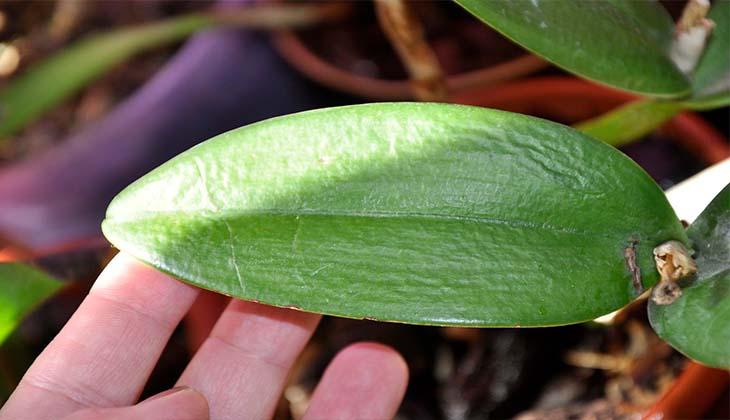

- if the roots change color to dark gray or brown;
- the substrate has become rotten, crumbling into lumps on the bottom of the container;
- there is a smell of mold or dampness;
- the soil has lost its density, while a lot of free space appeared in the container;
- the container after watering becomes heavier than before.
Important! The best time to transplant is when the orchid begins to release new roots and leaves.
Transplant process
To preserve the root system of the plant, the soil is changed in stages:
- First, try to pull the flower out without damaging the roots. Immediately after removing, immerse the orchid with soil in a bowl of warm water and leave until completely soaked for several hours.
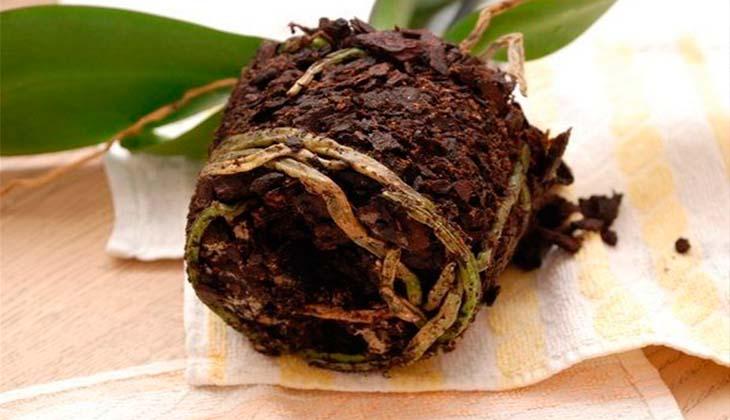

- When the lumps of soil have fallen off, rinse the residues from the roots from the shower with a stream of warm water.Then remove the damaged parts with a garden cleaver or scissors, and sprinkle with charcoal or cinnamon over the cut. This will keep moisture out of the stem.


- Then place the flower on a piece of paper and leave to dry completely. For a few hours, nothing will happen to the plant without nutrition. Indeed, in nature, an orchid grows on a tree, and its roots hang down.
- Next, prepare the substrate. It consists of a mixture of peat, moss, tree bark, fern roots and styrofoam. It is best to purchase ready-made soil in the store in advance. The substrate is poured into a container to a height of 5 cm, after which the plant is placed. Add soil on top of the roots and press lightly to lower it.
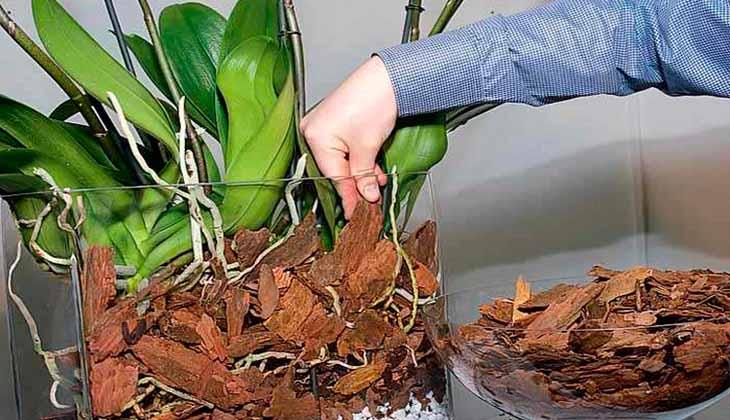

At the next stage, the pot together with the plant is immersed in water for 5 minutes, then removed and allowed to drain. If the soil has sunk heavily, add the substrate.
What if it doesn’t give an escape?
- Arrange the temperature difference. The difference between the thermometer readings at night and during the day should be 5C - 7C. This difference can be achieved by placing the orchid pot on a heated balcony or terrace.
- Provide enough light for the plant. The required duration of daylight hours is 10 - 12 hours. In the cold season (autumn, winter), the flower must be supplemented with a phytolamp.
- Provide proper watering. The orchid until the moment of flowering and with the release of the arrow requires moderate systematic watering. But it is important to remember the main principle: do not flood the roots! It is necessary to monitor the condition of the root system and substrate all the time.
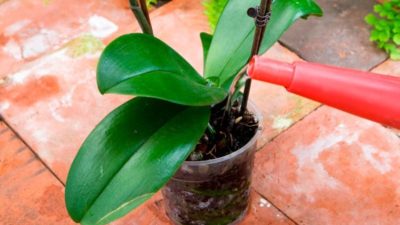

Monitor the humidity level in the room where the orchid is located. For the release of the arrow, the optimum humidity should be 30% - 40%.- Provide plant nutrition with fertilizers based on potassium and phosphorus: they have a beneficial effect on the formation of flower buds.
- Scare. If the above points were fulfilled, and the orchid did not release the arrow, then it is recommended to arrange a stressful situation for it: reduce watering to a minimum and rearrange the pot to a cooler place.
Some florists use special chemicals to stimulate orchid flowering. Epin is very popular. They should spray the plant daily in the morning.
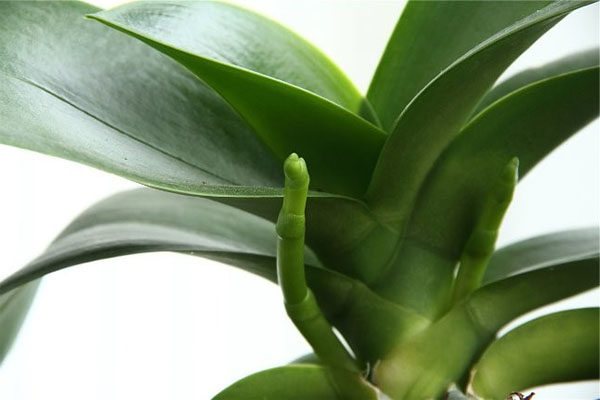

You can also water the plant by adding 3-5 drops of the drug to the water (see instructions for details).
A cytokinin paste is used as a phytoharmonic agent, and succinic acid is used as a growth regulator and antistress drug (dissolve 2 g in 1 liter of water).
Step-by-step instructions: what to do in a certain situation?
Consider what to do if the peduncle that grows from the point of growth is broken or other possible cases:
- Grows from a point of growth. This happens if the phalaenopsis has already undergone many flowering cycles or experienced severe stress. In this case, you do not need to take any action, you just need to take care of the plant and, perhaps, buds or children will appear on the arrow.
- Broken. In this case, you need to cut the peduncle to the bud located closest to the fracture site and treat the cut site with crushed activated carbon, wood ash or cinnamon powder.
What if there are no buds?
Many orchid lovers complain that their beauties are "sitting" in place, not pleasing with their flowering for several years. What should be done in such a situation for the plant to shoot an arrow? To begin with, just try to rearrange the flower to a new location. If it does not help, then there are several options for "shock therapy" that experienced florists strongly recommend.
Temperature drops
- Rearrange the flower with the pot in a place where there is a temperature difference of 5C - 7C: it should be cool at night, warm during the day. The best place is a balcony, veranda.
- It is imperative to check for drafts, since the plant does not tolerate them and may die.
- Move the container with the epiphyte to a darker place than what he is used to.
- Reduce as much as possible, and sometimes completely stop watering the plant, giving it a kind of "drought".
- After 1.5-2.5 weeks, carry out the first moderate watering.
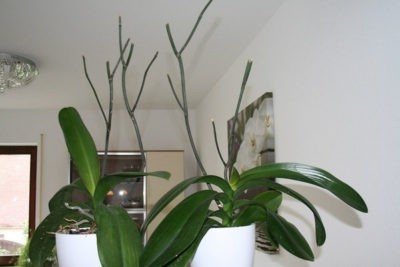

Reduce watering of an orchid in half: for example, if watering was carried out 1 time in 5 days, then you need to start watering the plant 1 time in 10 days.- Moderate watering with boiled water at room temperature is recommended between intervals of "drought".
- You cannot spray the plant at this time, moisten the substrate from the spray bottle.
It is unacceptable to apply several techniques at the same time, as this can lead to the death of the flower!
Reasons for the absence of a peduncle
The conditions for keeping an orchid depend on the variety and age of the plant. However, there are general requirements for care, non-observance of which will lead to a deterioration in the vitality of the flower. It is important to understand why the plant is not able to release the arrow.
Humidity level
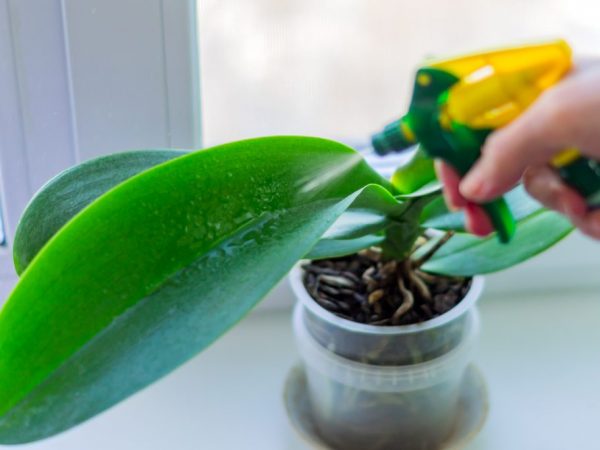

The moisture level affects the appearance of the peduncle
Orchids grow in low humidity, but too dry air will prevent the plant from forming a peduncle. Due to a lack of moisture, the buds may crumble without opening. The moisture level depends on the type of orchid:
- Vandas bloom occurs at 70-80% moisture in the air during the day and 60% at night;
- Dendrobiums and Phlenopsis require 30-40% humidity;
- Cattleya produce a peduncle at 40-50% humidity.
Air humidity is lowered when the flower is stimulated by the temperature drop method. Otherwise, the root system will freeze and the plant will die.
Indoor light
Daylight hours for Phalaenopsis and Dendrobium should be at least 8 hours. In winter, the plant requires additional light sources. Special phytolamps are used for illumination. The amount of light required depends on the type of plant:
- Cymbidium produces a peduncle at 12 hours of light;
- Paphiopedilum requires 14 hours of light;
- Catleys grow with a daylight hours of 12 hours.
Lack of lighting affects not only the ability of the plant to form a shoot. Without the right amount of light, an arrow will appear, but the plant will not bloom.
Watering mode
The arrow appears after stimulating the plant with the drought method. But, being without water for a long time, the flower will die. Moisture-free orchids shed the frog, conserving water in foliage and roots. Watering phalaenopsis and dendrobium is carried out by spraying 1 p. in Week. One spraying every 10 days is enough for sympodial varieties. These include:
- Maxillaria;
- Ludisia;
- Wanda.
Temperature
Temperature is one of the main factors affecting the appearance of an arrow. The temperature drop method is the main way to stimulate the orchid. However, at low temperatures, the flower sheds its peduncle. The level of heat depends on the variety:
- Phalaenopsis will not form an arrow if the room is below 16 ° C;
- Dendrobium dies at temperatures below 14 ° C;
- Cattleya and Wanda can withstand drops of up to 10 ° C, but indoors should be above 12 ° C.
A new arrow has broken
- Do not leave a broken arrow on the plant, do not glue it with tape, adhesive plaster, do not bandage it.
- Cut with sharp and sterile scissors 1 - 2 cm above the dormant bud. It is highly likely that a lateral peduncle will form from the dormant bud.
- If the peduncle has broken at the root, then you need to cut it off completely, trying to leave a small stump with a height of 1-2 cm.
- Sprinkle the cut area with cinnamon or crushed activated carbon.
- A broken arrow can be placed in water by changing it periodically. The orchid can start blooming this way.
So that such cases do not recur, it is necessary to provide the plant with such a habitat in which the probability of causing mechanical damage to the flower will be reduced to zero.Since plastic pots are not stable enough, it is advisable to place them in pots that are more stable: glass or ceramic.
Cutting off a wilted peduncle
Pruning methods differ for each type of orchid. In phalaenopsis, the peduncle is partially removed. To do this, you need to wait until the petals completely fall off. After wilting, a peduncle remains. If you do not cut it off, there may be several options on which it depends on what to do with the orchid next:


- when the peduncle has dried completely and darkened, it is removed;
- if there are buds on the stem, and the tip is green, you need to wait - buds may be tied;
- in case of incomplete drying of the stem, the waiting period is also extended: the arrow will deliver food, and then it will bloom again;
- if the stem is cut off early, the flower will need several months to recover, then new buds will appear only after six months;
- if the kidneys are swollen, the cut is made 2 cm above their level.
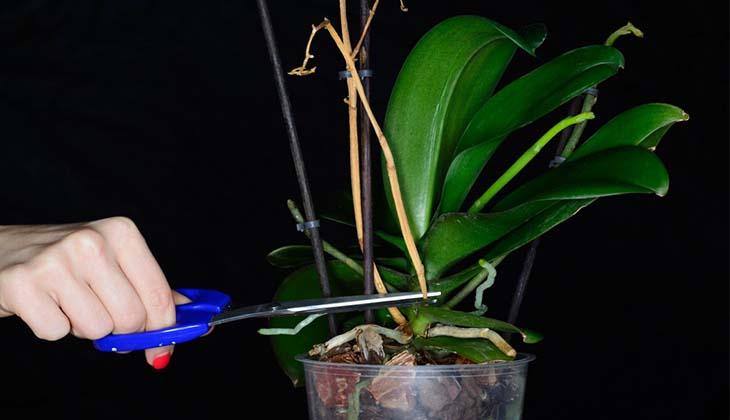

Photo: pruning a dried phalaenopsis peduncle
Important! In cases of doubt, it is safest to remove branches in October - November.
Sympodial orchid species regularly renew their flowers themselves, so the arrow is not removed from them. These include dendrobium, oncidium, cymbidium. In monopodial hybrids (wanda, doritis), the peduncle dries up along with the stem. It is removed at the base.
Where is the growth point at the arrow?
The point of growth of the arrow is in the axils of the leaves, but there are times when the flowering process grows directly from the outlet. It seems that such a process will not bring anything joyful. Indeed, in the future, the orchid will not be able to release a new leaf, and when the central peduncle dries up soon, there will be no children either. As a result, the plant will die.
However, there are Dutch hybrid varieties in which the arrow grows from the center. At the end of flowering, a new shoot appears, on which children are formed. After the complete formation and deposition of the children, the plant again releases a peduncle. Here is such a feature. Read more about what an orchid baby is and how to grow it on a peduncle here.


Wait until the arrow reaches a length of 15 - 20 cm. While it is green, it is very flexible and can easily change the direction of its growth.- The grown shoot must be fixed in an upright position using a support in a pot and a special clothespin (elastic bands, hairpins, etc.).
- If there is a risk of injury to the peduncle or even its scrapping, then fixation can be carried out gradually. In order to bring the peduncle as close as possible to the support, it is tied with an elastic band, rope, tape or bandage to the holder, gradually reducing the distance between them over time.
Pests and diseases
A diseased plant is unable to form an arrow. Among the main diseases affecting the peduncle are:
- Powdery mildew. As a treatment, the drug Skor or a solution of colloidal sulfur is used.
- Gray rot. A fungicide will help in the fight against it.
- Anthracnose. The disease is treated with the drugs Ritomil and Mikasan.
Pests can also cause the arrow to be missing. Common harmful insects are:
- Mealybug. The affected plant is treated with soapy water.
- Shield. For treatment, Actellik solution is used.
- Thrips. These insects are destroyed with Fitoverm.
How to care for Phalaenopsis during flowering.
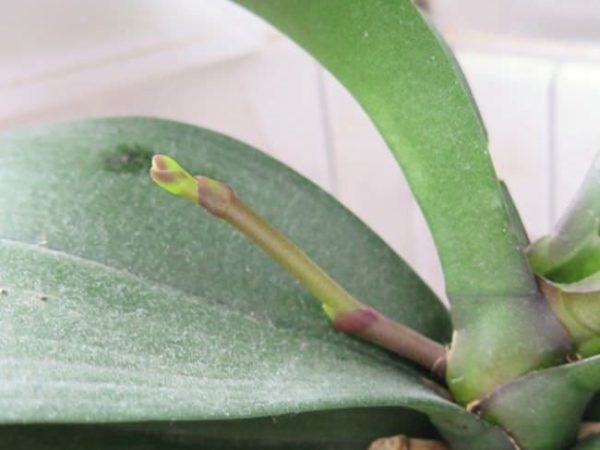

In order for an orchid to release an arrow and please for a long time with its flowering, you need to provide it with comfortable living conditions. To do this, you should:
- Maintain the temperature in the room in summer: 22-25 ° C, in winter 16-18 ° C.
- Place the pot in the sun, but not under the scorching rays. It is recommended to shade the window in summer.
- Maintain humidity during the growing season within 50-60% with a household humidifier, and for the release of the peduncle - 30% - 40%.
- Ventilate the room regularly.
- Water once a week, in between, the soil should dry out completely. For the release of the peduncle, the "dry" period can be extended.
- Use warm and purified water.
- Fertilize orchids with fertilizers containing potassium and phosphorus.
The real joy of the grower is the moment the orchid arrow appears. But it is important to remember that the key to the future successful flowering of a plant is compliance with the basic requirements for the conditions of the epiphyte, especially at the moment when the plant is most vulnerable.
Orchid stimulation
Sometimes, at home, the orchid does not bloom for a long time. The reason for this is the stable growth conditions.
In order for a home orchid to release a flower stalk, the plant is stimulated with stress. Stimulation is carried out in two ways - by the method of drought and temperature drop.
Drought method
Reducing watering causes the orchid to release a flower stalk. In the hot period, the flower is moistened with 1 p. in 4 days, in a cool one - 1 p. in Week.
During this period, foliage is not sprayed. 10 days after reducing watering, the leaves of the plant become lethargic and the flower begins to release an arrow. This method will cause the orchid to re-bud after a short break in flowering.
Temperature drop
In its natural environment, the orchid blooms in spring, after cold weather. At home, it is important to create the same temperature.
To do this, the pot must be placed on a loggia or balcony. The temperature drop should be no more than 5 ° C. This method will help achieve flowering from an orchid that has been dormant for a long time.
Required inventory
To properly prune the orchid after flowering, choose the appropriate tools. For manipulation you will need:
- garden pruning shears - the most suitable tool, does not leave burrs, while scissors or a knife can damage the leaves;
- disinfectant - they treat the instrument, as well as the cut sites, to prevent infection of the culture with diseases;
- gloves - tissue juice often causes skin burns.
Pruning shears can also be disinfected by keeping it in boiling water for a few minutes. Some growers soak the tool in a bleach solution.
What to do if leaves appear on a faded peduncle?
It is necessary to learn that faded peduncles are not completely cut off... They are shortened by a couple of eyes. Some orchid varieties, such as yellow or variegated, are not touched at all.
In phalaenopsis and some species of oncidiums, the peduncle is also usually cut off completely, since it can re-form buds. In zygopetalums and phalaenopsis, the formation of "children" can occur on them.
If circumcision or shortening is carried out, then you need to monitor the sterility of the instrument so as not to infect, and disinfect the cut sites with activated carbon or special preparations.
Advice! It is necessary to adhere to the rule: a live and green peduncle cannot be removed (only trimming a part of it is possible), and a dying or dried one is removed.
Possible problems
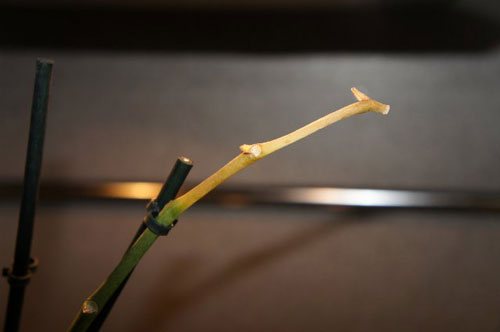

Sometimes in the epiphyte, the peduncle does not grow for a long time, or the arrow has grown incorrectly. Often, flower stalk breaks in flower growers with little experience. In this case, you need to understand the cause of the problem and determine the actions to solve it.


The principles of keeping a flower before and during the appearance of buds - what is the difference?
Care in these different periods is of course different, let's compare:
- Care before ejection of the peduncle- while the plant is resting (not blooming), it must be carefully looked after so that it has the strength for long flowering:
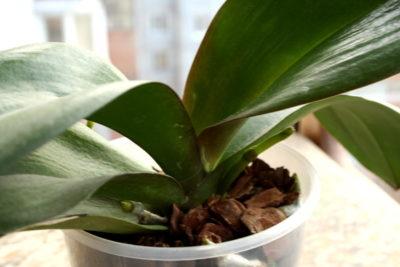

Watering is necessary as the roots dry out.- Maintain the correct humidity and temperature.
- The lighting must be active.
- Carefully and regularly inspect the flower for pests.
- You should not get carried away with top dressing, otherwise the Orchid may begin to "fatten", grow leaves and roots, but not bloom.
If it still does not bloom for a long time, it is necessary to arrange "stressing", that is, create conditions that are completely uncomfortable: either rearrange it to a darker place, or create a slight "drought" (sharply reduce watering). After such actions, peduncles usually arise.
Improper care and its consequences
With proper care, there should not be, in principle, any difficulties and problems, but, unfortunately, this is not always the case:
- firstly, it is not always possible to create ideal conditions for the plant to sprout flower stalks (read about why an orchid does not release a flower stalk and how to make it do it, read here);
- secondly, there is a problem in the lack of sufficient time for leaving.
Most often, the following can harm the plant:


Spider mites - an unpleasant white bloom appears on the leaves, a thin cobweb, it is noticeable along the edge of the leaf. This indicates insufficient air humidity, the flower needs to be thoroughly bathed in a shower (only warm), allowed to dry, and then treated with acaricides.- Scorms - they are white and look like small white lumps on the leaves. It is necessary to peel them off the leaves as soon as possible (you can use an alcohol-coated cotton swab), and then treat them with insecticides.
- Whitefly - a dangerous "butterfly" that can practically destroy the plant. You must first bathe it under a warm shower with laundry soap, and then also treat it with insecticides.
- Thrips - are capable of infecting both leaves and flowers at once, they pierce the leaf along the edges with their proboscis and suck out the juice, the leaf begins to turn yellow. It is urgent to put the plant under the shower, thoroughly rinse each leaf and flowers, and then process with Aktara.
The most common diseases due to improper care:
- Rotting defeat - fungal disease, you must immediately remove the affected leaves and sprinkle the cuts with charcoal. The reason for it is a lot of moisture at low temperatures.
- Fusarium - the leaves soften and become covered with a pinkish bloom, spots appear - treatment with Fundazol will help (within a week). The reason is stagnation and too much humidity.
- Powdery mildew - a white bloom appears on the leaves and buds, treatment with a solution of colloidal sulfur or the preparation "Skor" will help. The reason is in the creation of a "greenhouse effect", that is, too high temperature and humidity.
- Leaf spot - the appearance of dark wet spots indicates that you are too carried away with feeding. The leaves will have to be removed and the flower treated with a fungicide.
When to prune
The culture blooms from 2 to 6 months, sometimes several times a year, depending on the variety. For many of them, the completion of the flowering stage is determined by the changed color of the peduncle - it acquires a waxy shade. For the phalaenopsis orchid, pruning is carried out in the autumn months - October or November.
It is worth considering that some members of the orchid family bloom again. Therefore, make sure that the plant does not enter the flowering phase again. For this, the culture is left alone for a while. If the peduncle dries out completely, the procedure is started. In many species, it is performed when the stems acquire a brown tint.
You should also know when to prune the phalaenopsis orchid. Some growers do this immediately when it has faded. Then the culture will quickly please with new flowers. After manipulation, arrows will begin to form from additional dormant buds that are located on the shoot.The peduncle of this variety remains green for a long time. If it is not removed, the shoots will begin to grow. The branches will stretch too far. It will become difficult for a culture to cope with such dimensions.
Peduncle pruning for orchids of other varieties is not carried out if:
- The arrow is not completely dry. The plant receives nutrients with its help. If the organ is removed at this stage, the culture will spend a lot of energy on recovery. The next flowering will come no earlier than six months later.
- There are buds on the arrow or its tip is green. In this case, you should wait. The plant can bloom again. Phalaenopsis is distinguished by this feature. Although some growers are of the opinion about the need for circumcision, this will provide him with rest.
Aganizia
Iris care after flowering - when to prune the leaves
Aganizia is a small species. Such orchids are found only in South Africa. A distinctive feature is a thin and long stem. The petals of the flower are white. From the outside, it looks like an air cloud. Aganizia is also quite whimsical. For full growth, a large amount of light and moisture is needed. Aganizia prefers bright lighting, but the light should be diffused. Also tolerates partial shade well. The culture usually fades at the end of summer. Pruning is required closer to the beginning of autumn.


Aganizia
What species are pruned stalks
Depending on the type of orchid, the time for trimming the peduncles is chosen.
In some species, they are cut off immediately after flowering so that the arrow does not take nutrients and juices from the plant. Some are better not to touch until the peduncle is completely dry.
Monopodial orchids with vertical growth of shoots, the peduncles are cut off at the end of flowering. However, sometimes new buds appear on the same arrow.


Advice! Watch out for the appearance of the escape. If it's green, healthy, and won't dry out, don't rush to prune.
These orchids include:
- Phalaenopsis;
- Brassavola;
- Wanda;
- Aganizia, etc.
Sympodial orchids with horizontal growth of the pseudobulb, from which the peduncle appears, cut off after the shoot has completely dried.
Have sympodial orchids the stem without buds saturates the plant with nutrients and helps to form new shoots. If you cut it ahead of time, the bush will weaken due to lack of nutrition and may even die.
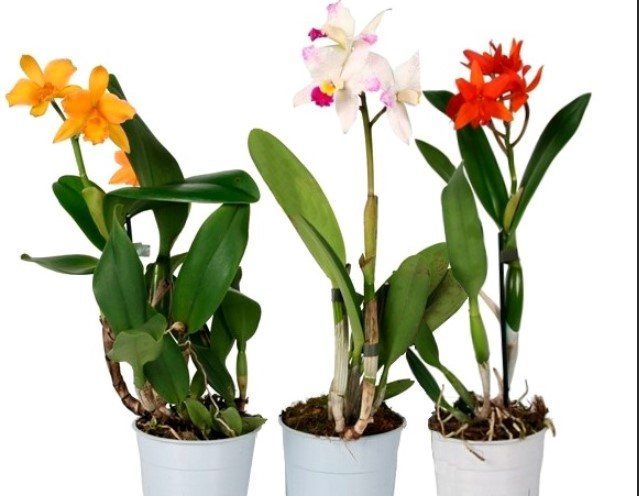

These orchids include:
- Cymbidium;
- Dendrobium;
- Miltonia;
- Cattleya, etc.
How to determine if circumcision is needed
Some species re-emit buds and bloom. This happens due to feeding or temperature stimulation, as well as if you do not have time to cut off in time.
If you notice that the dormant buds have increased, and buds have appeared on the arrow in the place of their former splendor, these are new flowers hatching. In this case, neat pruning of the shoots above the buds will help the orchid to bloom again.
Like any living organism, the epiphyte needs rest, and constant activity depletes it.
How and when to separate the baby?
How and when to separate the baby? The formation of a baby on a mother specimen is a natural process for an orchid. It looks like an adult plant, but in miniature form and mostly without flowers. However, sometimes the baby blooms right on the mother specimen, that is, even before separation. The photo is a vivid example.
One adult plant can have several small ones at the same time. They first form the leaves, and over time the roots. The presence of roots with a length of two centimeters is a signal that the baby can be cut off and planted. Practice shows that it is better to plant a small plant with three to four roots from five centimeters. In this case, the best survival rate is observed.
The process of separating the baby is similar to any trimming procedure. You need to take a sharp disinfected tool (knife, garden pruner or scissors) and carefully cut off, taking into account:
- Baby on a peduncle. It is trimmed so that one or two centimeters of the peduncle remain on both sides. The cut sites are processed with crushed activated carbon and dried for thirty minutes.
- New plant on the root (root location). In this case, first make sure there are roots, and then separate at the place where the baby and the mother are connected. The place of the cut should be sprinkled with either ground cinnamon or crushed activated carbon.
- Baby in the leaf sinus. In this case, at least one centimeter of maternal tissue is captured during pruning. The cut site must be processed immediately.
Then the baby needs to be planted in a greenhouse in a container with a small amount of substrate and maintaining comfortable conditions (temperature 28-29 degrees, humidity - 90%, illumination with soft and diffused light for 12 hours), if it is very small and needs active growth.
You can also use the watering and drying method. A container is needed where the baby is placed. Every morning, warm (5-7 degrees warmer than room) water is poured into the container so that the baby's roots touch it slightly. Keep the plant in this form for forty minutes, and then drain the water. The algorithm is repeated until longer roots are formed.
A large baby can be immediately planted in a pot with a substrate, which is represented by pine bark (fine fraction), particles of charcoal and sphagnum moss. The soil can be made with your own hands at home or purchased at a specialized store. Proceed in whatever way suits you best. Further, caring for the baby is similar to the content of an adult specimen.
Remember that pruning of any kind of orchid (phalaenopsis, wanda, cymbidium, etc.) is done if necessary. It is better not to disturb the plant unnecessarily. If possible, combine pruning with transplanting time so the plant doesn't get stressed twice. If only peduncles are cut, then a transplant is not needed. After the procedure, maintain a comfortable growing environment for the orchid so that it delights with abundant flowering and beauty.
25
How and how much do orchids bloom?
Different types of orchids bloom differently. For example, phalaenopsis flowers are shaped like butterflies, and dendrobium flowers are like miniature lilies. They also differ in the duration of flowering. With the creation of appropriate conditions and proper care, the flowering of phalaenopsis will be almost continuous. Dendrobium blooms seasonally, for several months. So, the orchid has faded, what to do next?
What it is
Inexperienced growers who have started growing orchids may confuse flower stalks with roots or young children. There are several signs and rules on how to distinguish a peduncle from other young parts of the plant.
The arrow provides all the beauty of the orchid. It has a tip that develops rapidly. If it is green, then the hope remains that new beautiful flowers will appear.
Definition
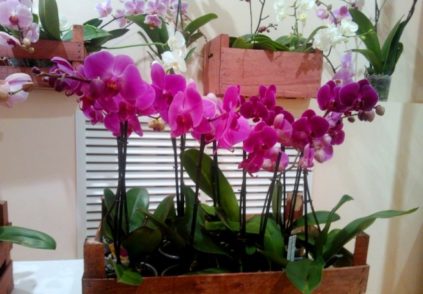

A peduncle is a shoot growing from the base of a flower. There will be beautiful flowers on it. If the orchid has released a healthy strong arrow, the number of flowers reaches 50. But this applies to a large adult culture.
On a note!
The arrow may look bizarre at first. The flowering shoot grows straight at the orchid, twists, bends. It takes a long period to form it. And only then the plant will bloom.
Where it can come from
Whichever type the peduncle initially takes, it appears from the point of growth or foundation of the culture. This helps to understand about its presence. If in doubt, the orchid releases an arrow or something else, pay attention to the place of formation.
The ability to recognize a peduncle is necessary for several reasons:
- During the flowering period, the orchid needs more attention. The mode of watering and feeding is changing.
- It is not always possible to let the plant bloom.If the orchid is sick or has undergone an emergency transplant, then it is more advisable to prevent flowering. The formation of a peduncle requires a lot of effort, the flower will not recover, it will not bloom beautifully.
- The orchid develops slowly, the peduncle grows for a long time. Therefore, sometimes it is just interesting to watch the development of a flower.
It is easy to distinguish a peduncle from a root (more differences). It is much easier to mix it up with a baby.
How to distinguish from root and baby
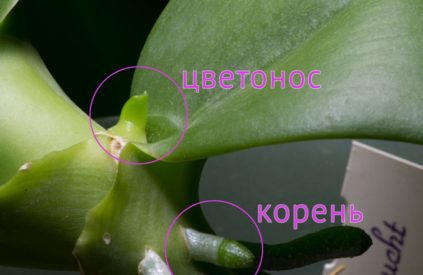

In order to correctly distinguish a peduncle from a child or a root in an orchid, they check the main signs and find differences.
- The current arrow grows slightly taller than it was in the previous season.
- It is very easy to distinguish from a basal baby when the arrow grows up a little. Its tip resembles a boat.
- It is easy to distinguish the peduncle of Phalaenopsis from the root. The shape of a young root is rounded, while that of a flower-bearing shoot is conical.
- The orchid releases a peduncle from the axil of the leaves, or rather, from the vein located in the center.
- Even on the youngest shoot, it is easy to notice roughness and irregularities; arrows differ from other parts of the plant by them.
When the Phalaenopsis arrow grows and develops, it is easy to recognize it among other parts of the plant.
How does a plant shoot an arrow?
The peduncle hatches at the bottom of the stem, under the leaf. Although there are chaotic locations. The appearance of a new arrow occurs under the influence of certain factors: temperature, humidity, lighting, watering. Under unfavorable conditions, the formation of a flowering process will be impossible.
Reference! The flowering process usually begins in the fall, when over the summer the orchid has gained strength and got stronger. And in winter, a period of dormancy begins. However, different varieties have different life cycles.
Flowering duration
How to understand that it is over?
First of all you need to take into account the characteristics of the species, since they are varied both in time and in the duration of flowering. Some have a few weeks, while others have a few months.
Secondly, conditions and care. Cessation of flowering may be due to improper care or unacceptable conditions for the species, as a result of which the plant sheds buds or flowers.
If this is a short-term phenomenon and, when errors are corrected, the plant continues to delight the grower, then flowering can continue further. Provided that the buds remain on the peduncle.
If the green, the usual color of the peduncle, begins to change color to pink - purple, brownish or wax colors, this means that flowering is over and the plant enters a dormant stage.
Why does it end quickly?
There can be no unambiguous answer to the question "Why did the orchids quickly faded?" Different types of orchids have different flowering times.
Some species can bloom all year round under optimal conditions. Depending on how to care for it, how to observe periods of rest, it can generally be continuous, for example, phalaenopsis.


With proper care, some Phalaenopsis can bloom all year round.
Important! An indicator of optimal conditions is the duration of flowering.
Do I need to trim the leaves
The leaf is the main element of the green mass of the flower. It takes part in photosynthesis and contributes to plant nutrition.
In other words: the more green organs there are, the stronger their bearer.
The leaves are removed if they have become wilted, soft and yellow: otherwise, the nutrition of the epiphyte is difficult, and in general the plant looks unkempt.
Only a slight imperfection is enough for the leaf to be rejected: it is not necessary to wait for complete drying.
It is important to know how to cut an orchid so as not to hurt healthy leaves: the leaf plate is cut in half and carefully removed without residues.
Care after pruning
The orchid after pruning requires proper care, since the procedure is stressful for it. Therefore, the plant is left alone for a while.If a culture goes into hibernation, then it must be looked after accordingly. For most species, this period lasts about 2 months.
Reduce watering. Water is added in moderation. The soil mixture should dry out between humidifications. Ventilate the premises. Culture does not tolerate drafts. If the air is too dry, it is humidified using special devices. The temperature should be 12 ° C-18 ° C, depending on the species. Top dressing is stopped. Provide good illumination.
If the orchid was cut in the summer, then it is shaded. The plant is protected from direct sunlight with curtains or a matte film, which is fixed to the window.
After trimming the lower leaves, watering is not done for several days in order to heal the wounds. Sometimes the green leaves become lethargic. In that case, it's worth the wait. They often acquire more elasticity. But if they start to dry out, the leaves should be cut off.
In some cases, the flower should be transplanted. During the procedure, the roots are examined. If rotten or dry are found, they should be cut off.
When the end of the dormant period approaches, they stimulate the conception of new flowers. This is achieved through temperature changes. The difference between the indicators during the day and at night should be 7 ° C. Such manipulations contribute to the ejection of the flower arrow.
Pruning procedure
It is important to remove only wilted parts so that all the forces of the orchid are directed to new shoots. Also, in no case should it be disturbed or cut off until it has bloomed to the end, this can destroy the plant.
When forming a peduncle, the main thing is not to damage the plant. There are two ways to trim:
- The peduncle is shortened partially above the sleeping bud, about 1.5 cm above it;
- Cut at the base, leaving a stump with a height of about 2.5-3 cm.
But there is one caveat: by cutting off the peduncle above the sleeping bud, you can slow down the growth of new stems. Because the orchid will spend energy on the development of the formed buds.
What is needed to prune an orchid at home? Better in advance buy a garden pruner... It injures the plant least of all, does not touch the leaves, and does not leave burrs. And microbes can get into them, which will lead to plant diseases. It is undesirable to use ordinary scissors or a knife; it is easy to damage the orchid with them.
Immediately before the procedure, the pruner must be disinfected. A bleach solution is quite suitable for this. You can also wipe it with alcohol or lower the blades in boiling water and hold for a while. They do this so as not to introduce an infection into the plant. You can always watch the video on how to prune an orchid.
After the procedure, the cut site is treated with crushed activated carbon, iodine, brilliant green or cinnamon... Some orchids have a hollow stem inside. When watering, water will get into it, and it can rot. And then the disease will spread to the whole flower. So it is better to close the cut on such a stem with beeswax.
Wanda
Wanda attracts attention with her unusual leaves. They come in a variety of colors, but most often they are purple. But they are all united by light specks on the sheets. In addition, some flowers have a delicate aroma. Inflorescences can be erect or hanging. Usually a wanda has many flowers, but sometimes there is also one large one.
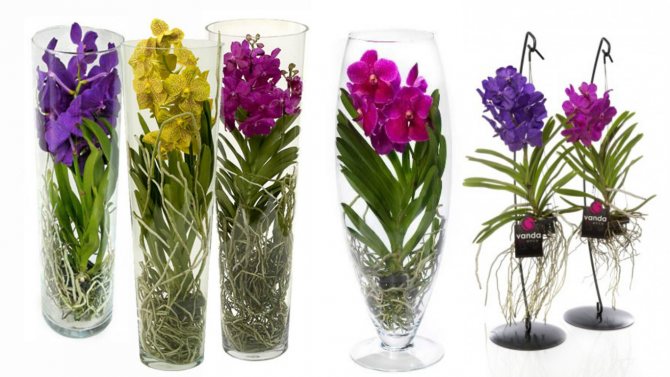

Wanda
For your information! Wanda has long and powerful aerial roots. They can be up to a meter in length.
This flower is quite unusual as it can grow outside the soil. It is very important for this orchid that the air flows directly to the roots. Most often, such plants are stored in transparent containers or even without them.
Wanda is a rather capricious specimen. It should only stand in a sunny place: on a window or balcony. The leaves quickly show signs of lack of sun. Most often they are expressed as pale spots.
What to do after flowering?
What to do with a flowering shoot after an orchid has flowered depends on its condition.
- If, after the flowering of the orchid, the peduncle has turned yellow and dried, it should be cut off at the base and sprinkled with cinnamon powder, crushed activated carbon or wood ash.
- If only the apical bud dries up, it is better to cut the branch with it to the first lower bud.
- If the peduncle is intact, it has a green tip and dormant buds, then nothing should be done - after a while new flowers may appear on it.
Read more about how to prune Phalaenopsis after flowering here.
We suggest watching a video on what to do with a peduncle after the orchid has faded:
The peduncle is very important for phalaenopsis, therefore, during the period of its growth, it is necessary to take particular care of the plant, and in case of problems, to be able to solve them correctly.
If you find an error, please select a piece of text and press Ctrl + Enter.
How to care after pruning
Since the shortening of the peduncle is stress for the plant, it is better not to disturb it for a while. And later, the orchid needs almost the same care as before flowering. Water it in moderation.so that the substrate has time to dry out, spray the leaves and soil from the spray bottle. But it is better to cut the fertilizer.
At this time, many orchids have a dormant time. She needs it for recovery, replenishment of energy reserves before the new growing season. The resting time of a plant depends on the species, but it usually lasts about 2 months, sometimes a little more or less. During this period, it is important:
- Observe the correct temperature regime. The optimal daytime temperature is no more than 24 ° C, the nighttime temperature is about 16 ° C;
- Reduce watering of the plant;
- Do not fertilize the orchid;
- It is advisable to keep it away from any heating appliances;
- The plant must be provided with diffused lighting.
If the procedure was carried out in the summer, the orchid must be shaded from the direct sun. You can block it with curtains or use matte film... The main thing is that she does not get leaf burns. But you should not completely deprive her of sunlight. After all, this plant is tropical.
When it blooms again after pruning, it depends primarily on its variety. This can be in a few months, and in other cases it takes a year to wait for flowering.
How to prune the roots of an orchid
The orchid has two types of roots:
- Aerial - these are modified processes of the root system of a plant, which serve for additional moisture absorption. They should be cut off only in case of decay (the cause is an excess of moisture) or death (may be a sign of insufficient watering).
- Root system - pruning is most often done during transplantation. Dead roots are removed with a sharp secateurs, and the cut is treated with crushed charcoal. Roots can dry out with insufficient watering or overuse of fertilizers, which causes a chemical burn.
If there are not many dried root shoots, physiological reasons may be the reason - natural death (this happens from time to time). Such roots are removed when the plant is transplanted. Most often, this procedure is carried out after the end of the flowering period and pruning of the peduncle.
You should not rush to prune the roots, some of them can sometimes be restored:
- the plant must be removed from the pot, shaken off the substrate;
- rinse the roots well in warm water, to soften which you can add half a teaspoon of baking soda;
- in the same water, the plant can be left for 20-30 minutes, perhaps some roots will come to life;
- you only need to cut off those processes that are completely dry.
For reference. In order not to make a mistake and not to remove living roots, you can conduct a kind of test. To do this, the orchid should be placed in water for a while. Healthy roots will become firm and green. Dead processes will remain brown or gray, there is no point in reanimating them, they must be pruned.
Orchid root pruning must be done correctly, following a number of rules:
- the pruning tool must be sharp, the injured root tissue will become a source of bacterial infection, and the plant can get sick;
- the best way for this purpose is a pruner;
- before the procedure, tools intended for trimming must be treated with any antiseptic (most often alcohol is used at home);
- the root shoot is removed to a healthy place;
- the cut must be sprinkled with crushed charcoal (activated carbon can be used);
- if the roots are badly damaged, they can be removed completely, so there is a chance to save the plant.
With a complete pruning of the root system, the orchid must be placed in water, it is recommended to change it every day. Water from the tap is not used; it must first be defended and softened.
New root shoots usually appear no earlier than 60 days. When the roots grow back (at least 5-6 cm), the orchid can be planted in a pot with a special soil.
How long should a flower rest?
The orchid is a peculiar and unpredictable plant, and each specimen has its own character. Therefore, there is no exact timing of the dormant period after flowering. Rest can last from a month to a year... To a large extent, the speed of recovery depends on the quality of care and the indoor climate. Important! In an effort to achieve rapid re-bud formation, impatient growers begin to artificially stimulate the awakening of the plant. As a result of improper actions, the plant may not have time to recuperate and will soon die.
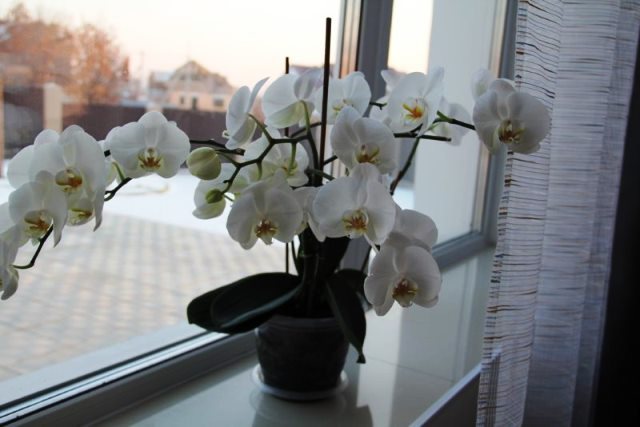

Orchid flowering stages
The flowering of an orchid begins with the appearance of flowering arrows - one or more, on which buds are formed. The more peduncles, the richer and more magnificent the flowering will be. The buds open gradually: during the day, the first one closest to the base of the arrow opens the petals, then the next one. A new flower appears every day. Blooming inflorescences - large, graceful, with a delicate aroma, amaze not only amateurs, but also people far from floriculture.
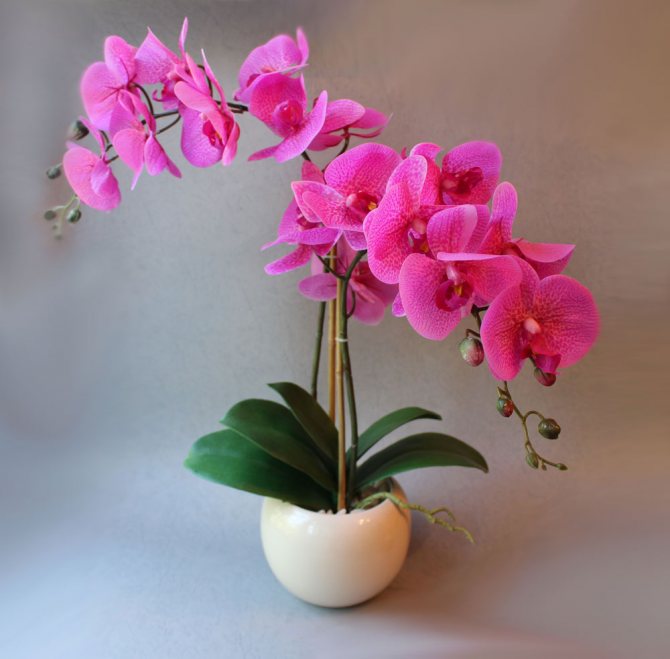

Phalaenopsis orchid bloom
Arrangement of a flower in a pot
The stems sometimes bend or bend under the weight of the buds. To prevent this from happening, they are tied to special sticks that are installed in a pot. For this, twine is used or special clips for orchids are purchased, which is much more convenient and looks aesthetically pleasing.


Securing the orchid arrows with special clamps
Orchid bloom lasts about three months, in some varieties up to six months, with a frequency of 2-3 times a year. The flowering frequency and duration directly depend on the care and conditions created.
Required conditions for flowering
- Bright location, out of direct sunlight. In case of insufficient lighting, you can supplement the plant with a phytolamp or fluorescent lamp.
- An orchid is planted in a transparent pot, since the orchid is an epiphytic plant, through the roots it receives not only water, air and nutrients, but also light, its root system participates in photosynthesis.
- Watering as the substrate dries up, moderate, without waterlogging.
- Temperature regime: for abundant flowering, it is necessary to provide the plant with a small difference between night and day temperatures. Ideally, maintain 20-23 degrees during the day, 16-18 at night.
- The orchid does not like permutations, and any change in location, even a simple turn, can end up dropping the buds.
- Weekly application of special dressings, for example, Agricola for orchids, where the composition of trace elements is selected specifically for flowering. In addition, the bottle is equipped with a measuring cup, which makes the use of this fertilizer convenient.
Fundamental rules
The basic rules of pruning must be known in order to minimize injury to the plant.First you need to pay attention to the selection of devices, which you cannot do without. These include:
- A garden pruner is the best option as it will not injure the stem when pruning. Can be replaced with sharp scissors or a knife, but you need to act carefully.
- Alcohol or other disinfectant (you can use bleach or the boiling method). They need to process the tool before trimming.
Next, you need to determine the cut point:
- If this is a peduncle (peduncle), then you need to prune over the sleeping bud at a height of one or two centimeters. Moreover, the closer the bud is to the leaf outlet, the more flowers will be formed on the lateral shoot formed in the future. However, re-flowering should be expected no earlier than two to three months after pruning.
- If it is an aerial root (rotten or completely rotten, frozen, dry, dying), then pruning is performed with a capture of one to two centimeters of healthy tissue. Remember that in this case you will also need to transplant the plant into a suitable pot with fresh substrate.
- If it is a leaf (dry, diseased, frozen, yellowed, swollen, etc.), then trimming is done so as to capture about two centimeters of healthy tissue.
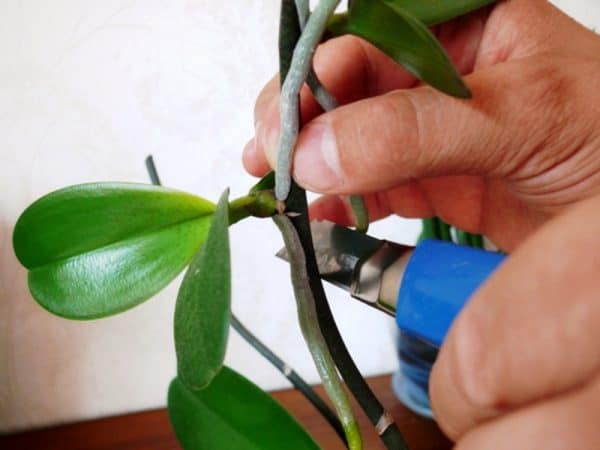

Next, it is imperative to process the cut site. For this, crushed activated carbon, ground cinnamon, brilliant green or iodine are suitable. Any of these agents is an excellent antiseptic that disinfects. Then the processed cut must be dried for at least twenty minutes.
Note! Sometimes after pruning, a hollow stem may appear, which is commonly called a hemp. During watering, water will accumulate in it, which, as a result, will lead to rotting of the outlet and disease of the plant. Ordinary beeswax, which is used to cover the hole, will help to avoid such a problem.
Poor plant care and consequences
- It so happens that the owner of the flower does not have enough time to take care of it at the proper level.
- Also, it is not always possible to create ideal conditions for the orchid to throw out the peduncle.
- Improper care can lead to the appearance of different types of parasites: worm, spider mite, whitefly, thrips.
The most common illnesses associated with poor orchid care are:
- RotIs a type of fungal disease. All affected areas are urgently removed, and the sections are disinfected.
Orchid is an exotic flower that requires special attention. Proper care - guarantees regular and lush flowering, disease-free, healthy appearance of the plant.
Premature drying of the peduncle
The peduncle is a temporary shoot of a flower. Its life is characterized by 1-2 flowering periods. Premature flowering ends are rare. If Phalaenopsis faded quickly, this indicates poor plant immunity, its unpreparedness for budding.
If the orchid has faded prematurely, the condition of the plant roots is checked. They should not be wet or moldy. Healthy roots are firm, green. The damaged root system is trimmed, removing all areas affected by rot, and also transplanted into a new substrate.
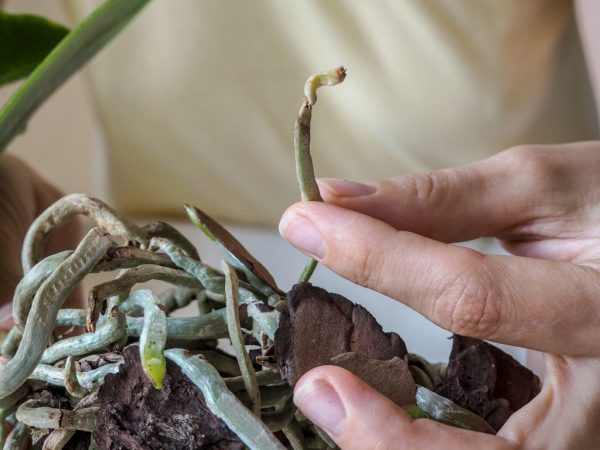

If the orchid has faded prematurely, the condition of the plant roots is checked.
How to prevent a stop in arrow development


When a peduncle has appeared on the plant, it is important to create comfortable conditions. Then the arrow will constantly develop and will not stop developing. For this, it is important to ensure that the lighting does not dim. If the duration of daylight hours is reduced, additional lighting with phytolaps is organized.
Watering gradually decreases and increases the interval between them. In this case, it is important not to overdry the plant. The room temperature is kept at an optimal level for good vegetation. Fertilizers are applied on time in accordance with the attached instructions.
Dormant period
The dormant state occurs in winter, after the flowering period. At this time, the plant slows down its growth and the metabolic rate decreases. Favorable conditions for wintering will be created by the following factors:
- the temperature regime should be lowered;
- feeding once a month;
- watering is reduced to ripen the growth and book the flower bud.
The plant goes into hibernation and, therefore, all faded flower stalks must be removed in order for the green friend to grow stronger and be able to please with its beauty next season.
Specific nuances
Has the orchid faded quickly or the peduncle has dried out prematurely? This can happen for two reasons:
- a problem with the root system - a transplant is needed;
- lack of moisture can lead to drying of the peduncle, which did not have time to bloom.
Important! The transplant is carried out only after the phalaenopsis orchid has faded.
A bit of theory
A flower stalk is an orchid sprout bearing flower buds... One peduncle can have from 1 to 30 flower buds, it all depends on the species.
Why do plants produce flower stalks? At the genetic level, every living creature and plant has a procreation program. And the orchid bloom is nothing but desire to continue your family.


With the help of flowering, the orchid seeks to continue its genus.
It happens that a sick plant that has not been flowering for a long time suddenly releases a peduncle, wanting to continue itself, and then dies. Therefore, orchid owners sometimes introduce a flower into a state of stress to achieve flowering.
In case, nevertheless, the orchid gave an arrow - how to care for it? We will also talk about this in our article.
Photo
Next, you can see the photo in which you can see the arrow of the orchid:
Features of the flowering period
When the plant is strewn with flowers, any changes in the environment are painful. The pot should not be moved to another place, the temperature and humidity should not be changed. Even turning the other side to the light source can cause the buds to shed, and if water gets on the petals when watering or spraying, they will be covered with spots. All activities are carried out only when the flowering is completed.
